Paul van Yperen's Blog, page 331
October 9, 2016
Irma Gramatica
Irma Gramatica (1867-1962) was an Italian stage and screen actress, known for her qualities but also for her temper. Gramatica appeared in ten films during her career. She was the sister of actress Emma Gramatica.

Italian postcard, no. 48. Photo: Sciutto, Genoa.
Enormous potential
Irma Gramatica was born as Maria Francesca Gramatica in 1867 in Fiume, Italy, now Rijeka, Croatia. She was the daughter of Domenico Gramatica and the Hungarian Cristina Bradil, respectively a prompter and a seamstress in the company of Luigi Monti.
She had two sisters, both actresses as well: Emma Gramatica and Anna Capodaglio. Though born Maria Francesca, she was called Irma from her childhood. In Carnia, Friuli, where she was raised, all Mariafrancesca’s were called Irma.
Already at the age of five years she debuted on stage in the drama Cause ed effetti by Paolo Ferrari and she immediately showed enormous potential. In her girlhood she starred alongside the great players of the time. She suported Cesare Rossi, Jacinta Pezzana, Flavio Andò and Eleonora Duse in the play Fedora by Victorien Sardou. She also joined them in a major tour through South America.
There the first symptoms of imbalance began to appear. Irma tried to commit suicide by eating exotic fruit contaminated by yellow fever. The reason is unknown but seems linked to difficulties related to a great inner pain, not to sentimental origins.
At seventeen she married the actor Arnaldo Cottin and they had a son the following year. With Cottin she returned to Argentina two years later. During the tour, their child, left back in Italy, died. The incident led to the separation of Gramatica and her husband.
While remaining in Argentina, Irma contracted meningitis from which she was saved, but anemic and weakened by an intense nervous breakdown she suffered a deep depression, beginning to perceive her existence as an unbearable burden.
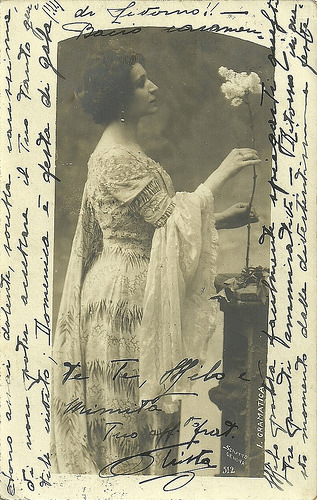
Italian postcard, no. 512. Photo: Sciutto, Genoa.
Outstanding temperament
After her return to Italy in 1892, Irma Gramatica became 'First Young Actress' in the company of Italia Vitaliani and Vittorio Salsilli in 1892. In 1895, she became 'primattrice' (First Actress), under the guidance of Napoleone Mozzidolfi and directed by Alessandro Marchetti. Under the guidance of V. Valli she perfected her outstanding temperament, suitable for a very wide repertoire.
Irma proved to be sensitive both to the new theatre as well as the romantic authors of the 19th century. After leaving Eleonora Duse ’s company, Irma entered that of Ermete Zacconi , an actor about whom Irama said that he "had absolute influence on the conduct of my artistic faculties."
From here began her great successes that led to the birth of the famous stage company Talli-Gramatica-Calabresi. Irma was the first Nennele in Come le foglie by Giuseppe Giacosa, Lisa in Dal tuo al mio by Giovanni Verga, and Paolina in Sperduti nel buio by Roberto Bracco.
A highlight was her role as Mila di Codro in La figlia di Jorio. Gabriele D'Annunzio had written this play especially for Eleonora Duse but because of illness, Duse could not perform the part on stage.
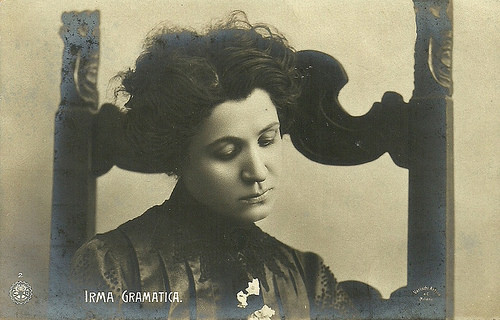
Italian postcard by TCR, no. 2. Photo: Varischi & Artico Co., Milano.
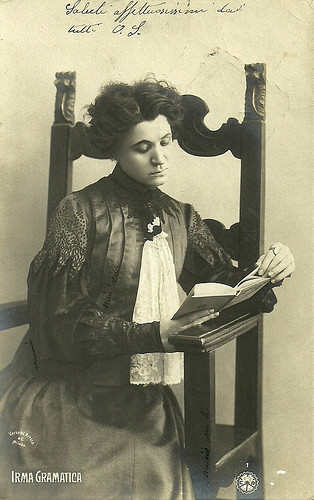
Italian postcard by T.C.R., no. 1. Photo: Varischi & Artico Co., Milano.
A severe nature
Irma Gramatica had a grumpy and irritable character. She called it herself a 'severe nature'. Irma always tried to be approached as little as possible, and admitted that she detested interviews. She fely a real phobia for them and almost always rejected them.
In the late 1930s and early 1940s she was active as film actress at the new Cinecittà studios. Sometimes she paired with her sister Emma as in Sissignora/Yes, madam (Fernando Maria Poggioli, 1941), starring María Denis , and in the comedy Sorelle Materassi/The Materassi Sisters (Fernando Maria Poggioli, 1944).
Among her young co-stars in those years were Laura Adani, Clara Calamai , Maria Mercader and German actress Anneliese Uhlig .
Irma also played the widow Pescatore in the Italian version of Il fu Mattia Pascal/The Former Mattia Pascal (Pierre Chenal, 1937), starring Pierre Blanchar . The film is based on the 1904 novel The Late Mattia Pascal by Luigi Pirandello.
Immediately after the war she had an important part in the refugees film Lo sconosciuto di San Marino/Unknown Men of San Marino (Michał Waszyński, 1946), starring Anna Magnani , and for which Cesare Zavattini had written the script.
Her last part was in Incantesimo tragico/Tragic Spell (Mario Sequi 1951), a period drama about a cursed treasure, set in the Maremma region. Her co-stars were María Félix , Rossano Brazzi , Massimo Serato and Charles Vanel .
Irma Grammatica died in Villa Giuseppina at Tavarnuzze in 1962. She was 91.

Italian postcard. Photo: Irma and Emma Grammatica, María Denis and Leonardo Cortese in Sissignora/Yes, Madam (Ferdinando Maria Poggioli, 1941).
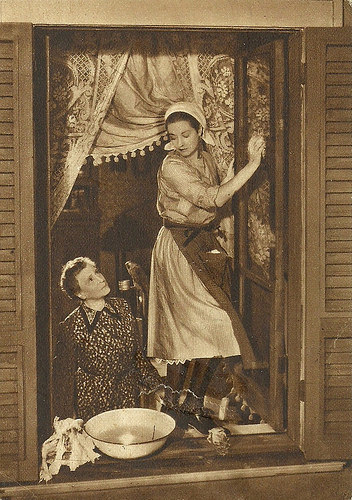
Italian postcard. Photo: Irma or Emma Grammatica and María Denis in Sissignora/Yes, Madam (Ferdinando Maria Poggioli, 1941).
New Monday a post on Irma's sister Emma Gramatica.
Sources: Wikipedia (Italian and English) and .

Italian postcard, no. 48. Photo: Sciutto, Genoa.
Enormous potential
Irma Gramatica was born as Maria Francesca Gramatica in 1867 in Fiume, Italy, now Rijeka, Croatia. She was the daughter of Domenico Gramatica and the Hungarian Cristina Bradil, respectively a prompter and a seamstress in the company of Luigi Monti.
She had two sisters, both actresses as well: Emma Gramatica and Anna Capodaglio. Though born Maria Francesca, she was called Irma from her childhood. In Carnia, Friuli, where she was raised, all Mariafrancesca’s were called Irma.
Already at the age of five years she debuted on stage in the drama Cause ed effetti by Paolo Ferrari and she immediately showed enormous potential. In her girlhood she starred alongside the great players of the time. She suported Cesare Rossi, Jacinta Pezzana, Flavio Andò and Eleonora Duse in the play Fedora by Victorien Sardou. She also joined them in a major tour through South America.
There the first symptoms of imbalance began to appear. Irma tried to commit suicide by eating exotic fruit contaminated by yellow fever. The reason is unknown but seems linked to difficulties related to a great inner pain, not to sentimental origins.
At seventeen she married the actor Arnaldo Cottin and they had a son the following year. With Cottin she returned to Argentina two years later. During the tour, their child, left back in Italy, died. The incident led to the separation of Gramatica and her husband.
While remaining in Argentina, Irma contracted meningitis from which she was saved, but anemic and weakened by an intense nervous breakdown she suffered a deep depression, beginning to perceive her existence as an unbearable burden.

Italian postcard, no. 512. Photo: Sciutto, Genoa.
Outstanding temperament
After her return to Italy in 1892, Irma Gramatica became 'First Young Actress' in the company of Italia Vitaliani and Vittorio Salsilli in 1892. In 1895, she became 'primattrice' (First Actress), under the guidance of Napoleone Mozzidolfi and directed by Alessandro Marchetti. Under the guidance of V. Valli she perfected her outstanding temperament, suitable for a very wide repertoire.
Irma proved to be sensitive both to the new theatre as well as the romantic authors of the 19th century. After leaving Eleonora Duse ’s company, Irma entered that of Ermete Zacconi , an actor about whom Irama said that he "had absolute influence on the conduct of my artistic faculties."
From here began her great successes that led to the birth of the famous stage company Talli-Gramatica-Calabresi. Irma was the first Nennele in Come le foglie by Giuseppe Giacosa, Lisa in Dal tuo al mio by Giovanni Verga, and Paolina in Sperduti nel buio by Roberto Bracco.
A highlight was her role as Mila di Codro in La figlia di Jorio. Gabriele D'Annunzio had written this play especially for Eleonora Duse but because of illness, Duse could not perform the part on stage.

Italian postcard by TCR, no. 2. Photo: Varischi & Artico Co., Milano.

Italian postcard by T.C.R., no. 1. Photo: Varischi & Artico Co., Milano.
A severe nature
Irma Gramatica had a grumpy and irritable character. She called it herself a 'severe nature'. Irma always tried to be approached as little as possible, and admitted that she detested interviews. She fely a real phobia for them and almost always rejected them.
In the late 1930s and early 1940s she was active as film actress at the new Cinecittà studios. Sometimes she paired with her sister Emma as in Sissignora/Yes, madam (Fernando Maria Poggioli, 1941), starring María Denis , and in the comedy Sorelle Materassi/The Materassi Sisters (Fernando Maria Poggioli, 1944).
Among her young co-stars in those years were Laura Adani, Clara Calamai , Maria Mercader and German actress Anneliese Uhlig .
Irma also played the widow Pescatore in the Italian version of Il fu Mattia Pascal/The Former Mattia Pascal (Pierre Chenal, 1937), starring Pierre Blanchar . The film is based on the 1904 novel The Late Mattia Pascal by Luigi Pirandello.
Immediately after the war she had an important part in the refugees film Lo sconosciuto di San Marino/Unknown Men of San Marino (Michał Waszyński, 1946), starring Anna Magnani , and for which Cesare Zavattini had written the script.
Her last part was in Incantesimo tragico/Tragic Spell (Mario Sequi 1951), a period drama about a cursed treasure, set in the Maremma region. Her co-stars were María Félix , Rossano Brazzi , Massimo Serato and Charles Vanel .
Irma Grammatica died in Villa Giuseppina at Tavarnuzze in 1962. She was 91.

Italian postcard. Photo: Irma and Emma Grammatica, María Denis and Leonardo Cortese in Sissignora/Yes, Madam (Ferdinando Maria Poggioli, 1941).

Italian postcard. Photo: Irma or Emma Grammatica and María Denis in Sissignora/Yes, Madam (Ferdinando Maria Poggioli, 1941).
New Monday a post on Irma's sister Emma Gramatica.
Sources: Wikipedia (Italian and English) and .
Published on October 09, 2016 22:00
October 8, 2016
Donatien
French actor, director and art director Donatien aka Emile-Bernard Donatien (1887-1955) was active in silent French cinema of the 1920s.

French postcard by Editions Cinémagazine, Paris, no. 214.
Jack-of-all-Trades
Donatien was born Emile-Charles-Bernard Wessbecher in Paris but from Alsacian descent, in 1887. After his studies he focused on art decoration for the theatre and in 1918 he opened a shop and ateliers in Paris and Deauville.
He started in cinema in 1919 as production designer thanks to Marcel L'Herbier, who took him on for his film Rose-France (Marcel L'Herbier, 1919) with Jaque Catelain . L'Herbier helped him to establish a reputation in designing apartments and collecting Medieval and Chinese antiques.
Rose-France was followed by Li Hang le Cruel/Li Hang the Cruel (1920) by Edouard-Emile Violet with whom Donatien often would collaborate. He played in three more films by Violet: Les mains flétries/The Branded Hands (Edouard-Emile Violet, 1920), L'auberge/The inn (Donatien, Edouard-Emile Violet, 1922) based on a novel by Guy de Maupassant, and La ruse/The guile (Edouard-Emile Violet, 1924), and codirecting with him L'auberge and Les hommes nouveaux (Donatien, Edouard-Emile Violet, 1922).
In fact, in 1920 Donatien had not only expanded his activities with film directing and film acting, playing in and directing Une histoire de brigands (Donatien, 1920), but he really became the jack-of-all-trades, as art director, costume designer, actor, director, editor and producer.
From 1922 on, Donatien's career went into overdrive, directing one film after another, often with himself in the lead or in a supporting role, and with Lucienne Legrand in the female lead. Privately, she was his partner as well. The couple was much helped by French film mogul Louis Aubert, who enabled them to shoot in various countries and realize prestigious period pieces such as Florine, la fleur du Valois/Florine, the flower of Valois (Donatien, 1926) or the science fiction film Le chateau de la mort lente/The castle of the slow death (Donatien, 1925).
Donatien's overall presence was even sustained by showing him on the title role, inspecting his own celluloid. Of course set decoration was highly present in his films, accentuated by light effects.

Lucienne Legrand. French postcard by A.N., Paris, no. 159. Photo: G.L. Manuel Frères.
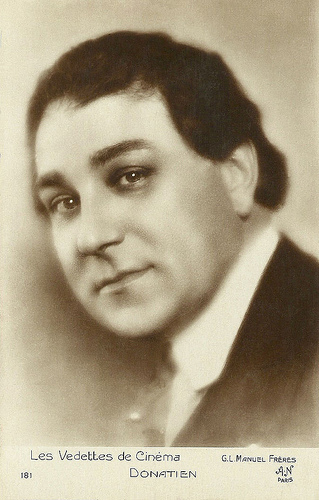
French postcard by A.N., Paris, no. 181. Photo: G.L. Manuel Frères. Collection: Didier Hanson.
Arrested by the Gestapo
Donatien aborted a collaboration in Germany after he shot only one film, Miss Edith, duchesse (Donatien, 1929) starring Lucienne Legrand and Rolla Norman . He returned to France to direct his last silent film L'arpète (Donatien, 1929) with Lucienne Legrand.
In 1930 he made the film Pogrom, shot in Palestine, Tunisia, Greece and the Cote d'Azur. Tragically the negative burned down at the laboratory of Eclair in Epinay. Painstakingly Donatien made one sound film, a remake of Mon cure chez les riches/My cure to the rich (Donatien, 1932), and then quitted film altogether.
He left Paris and established himself in the Jura, where he directed some stage plays and focused on ceramics. He was arrested by the Gestapo in 1940 and hardly escaped deportation.
Donatien was the uncle of actress Claude Romet, who is told to have helped Donatien in the 1950s when he focused on ceramics. He was also the cousin of general Marie-Pierre Koenig.
It seems that because of his reputation as an art decorator, Donatien never reached real fame as filmmaker. Emile-Bernard Donatien died in 1955 in Appoigny, France.
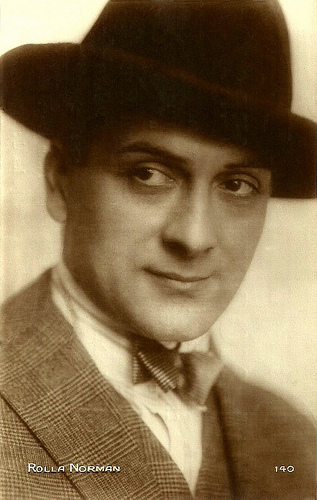
Rolla Norman . French postcard by Editions Cinémagazine, no. 140.
Sources: CinéRessources (French), 1895 (French), Wikipedia (French), and .

French postcard by Editions Cinémagazine, Paris, no. 214.
Jack-of-all-Trades
Donatien was born Emile-Charles-Bernard Wessbecher in Paris but from Alsacian descent, in 1887. After his studies he focused on art decoration for the theatre and in 1918 he opened a shop and ateliers in Paris and Deauville.
He started in cinema in 1919 as production designer thanks to Marcel L'Herbier, who took him on for his film Rose-France (Marcel L'Herbier, 1919) with Jaque Catelain . L'Herbier helped him to establish a reputation in designing apartments and collecting Medieval and Chinese antiques.
Rose-France was followed by Li Hang le Cruel/Li Hang the Cruel (1920) by Edouard-Emile Violet with whom Donatien often would collaborate. He played in three more films by Violet: Les mains flétries/The Branded Hands (Edouard-Emile Violet, 1920), L'auberge/The inn (Donatien, Edouard-Emile Violet, 1922) based on a novel by Guy de Maupassant, and La ruse/The guile (Edouard-Emile Violet, 1924), and codirecting with him L'auberge and Les hommes nouveaux (Donatien, Edouard-Emile Violet, 1922).
In fact, in 1920 Donatien had not only expanded his activities with film directing and film acting, playing in and directing Une histoire de brigands (Donatien, 1920), but he really became the jack-of-all-trades, as art director, costume designer, actor, director, editor and producer.
From 1922 on, Donatien's career went into overdrive, directing one film after another, often with himself in the lead or in a supporting role, and with Lucienne Legrand in the female lead. Privately, she was his partner as well. The couple was much helped by French film mogul Louis Aubert, who enabled them to shoot in various countries and realize prestigious period pieces such as Florine, la fleur du Valois/Florine, the flower of Valois (Donatien, 1926) or the science fiction film Le chateau de la mort lente/The castle of the slow death (Donatien, 1925).
Donatien's overall presence was even sustained by showing him on the title role, inspecting his own celluloid. Of course set decoration was highly present in his films, accentuated by light effects.

Lucienne Legrand. French postcard by A.N., Paris, no. 159. Photo: G.L. Manuel Frères.

French postcard by A.N., Paris, no. 181. Photo: G.L. Manuel Frères. Collection: Didier Hanson.
Arrested by the Gestapo
Donatien aborted a collaboration in Germany after he shot only one film, Miss Edith, duchesse (Donatien, 1929) starring Lucienne Legrand and Rolla Norman . He returned to France to direct his last silent film L'arpète (Donatien, 1929) with Lucienne Legrand.
In 1930 he made the film Pogrom, shot in Palestine, Tunisia, Greece and the Cote d'Azur. Tragically the negative burned down at the laboratory of Eclair in Epinay. Painstakingly Donatien made one sound film, a remake of Mon cure chez les riches/My cure to the rich (Donatien, 1932), and then quitted film altogether.
He left Paris and established himself in the Jura, where he directed some stage plays and focused on ceramics. He was arrested by the Gestapo in 1940 and hardly escaped deportation.
Donatien was the uncle of actress Claude Romet, who is told to have helped Donatien in the 1950s when he focused on ceramics. He was also the cousin of general Marie-Pierre Koenig.
It seems that because of his reputation as an art decorator, Donatien never reached real fame as filmmaker. Emile-Bernard Donatien died in 1955 in Appoigny, France.

Rolla Norman . French postcard by Editions Cinémagazine, no. 140.
Sources: CinéRessources (French), 1895 (French), Wikipedia (French), and .
Published on October 08, 2016 22:00
October 7, 2016
Diana Rigg
English actress Diana Rigg (1938) is well known as Emma Peel in the classic TV series The Avengers (1965-1968), and now as Lady Olenna Tyrell in Game of Thrones (2013-). In between she had an extensive career in film and theatre. Between 1959 and 1964, she performed for the Royal Shakespeare Company and won several awards, including a Tony and an Emmy award. In the cinema, she made her mark as Countess Teresa di Vicenzo, the only Bond girl to ever get 007 to the altar, in On Her Majesty's Secret Service (1969).

German postcard by Ludw. Povel & Co, Nordhorn.

French postcard by Universal Collections, 2002. Photo: Canal+ Image UK Ltd.
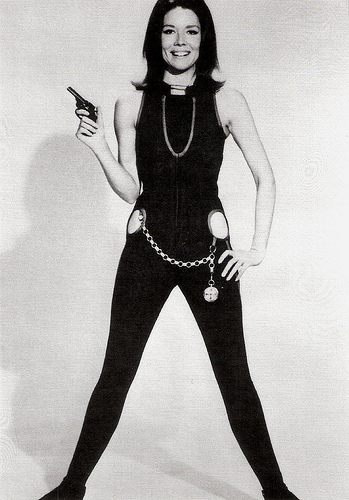
French postcard by Universal Collections, 2002. Photo: Canal+ Image UK Ltd.
Captivating little boys of all ages
Enid Diana Elizabeth Rigg was born in Doncaster, then in the West Riding of Yorkshire, now in South Yorkshire, in 1938. Her parents were railway engineer Louis Rigg and his wife Beryl Hilda Rigg née Helliwell. Between the ages of two months and eight years Rigg lived in Bikaner, India, where her father was employed as a railway executive.
She was then sent to a private boarding school, where she suffered through the discipline and rigours until one of her teachers introduced her to the world of the theatre. From 1955 till 1957, she trained as an actress at the Royal Academy of Dramatic Art, where Glenda Jackson and Siân Phillips were among her classmates.
Rigg made her professional stage debut in the RADA production of The Caucasian Chalk Circle at the York Festival in 1957. In 1959, she joined the Royal Shakespeare Company and stayed there till 1964. Her deeply distinctive voice, auburn red hair, and towering height (5'8") assured her such dynamic roles as Viola in Twelfth Night and Cordelia in King Lear.
In 1965, actress Elizabeth Shepherd was dropped from a popular BBC TV series after filming two episodes. Rigg auditioned for the role on a whim, without ever having seen the programme. Hal Erickson at AllMovie : “she was selected to replace Honor Blackman on the popular tongue-in-cheek TV-adventure series The Avengers and for the next two years captivated little boys of all ages with her energetic portrayal of coolheaded, leather-clad karate expert Mrs. Emma Peel.”
Fans were fond of the banter between Mrs. Peel and Patrick Macnee’s John Steed, delivered with champagne crispness. From 1965 till 1967, Rigg appeared in 51 episodes of the cult series. She became soured on the series when she discovered that she was earning less than some of the cameramen. After holding out for a pay raise, she returned for a second season, which would be her last.
Then film stardom followed. She became a Bond girl in On Her Majesty's Secret Service (Peter R. Hunt, 1969), playing Countess Teresa di Vicenzo a.k.a. Tracy Bond, 007's only wife, opposite George Lazenby. Although its cinema release was not as lucrative as its predecessor You Only Live Twice, On Her Majesty's Secret Service was still one of the top performing films of the year.
Critical reviews upon release were mixed, but the film's reputation has improved over time. Donald Guarisco at AllMovie : “Diana Rigg also makes a vivid impression as Tracy, easily the toughest and most resourceful of all Bond heroines”. Rigg’s other films from this period include her film debut A Midsummer Night's Dream (Peter Hall, 1968), the black comedy The Assassination Bureau (Basil Dearden, 1969) with Oliver Reed, Julius Caesar (Stuart Burge, 1970) featuring John Gielgud , and the satire The Hospital (Arthur Hiller, 1971). All her films were well regarded but no box office hits.
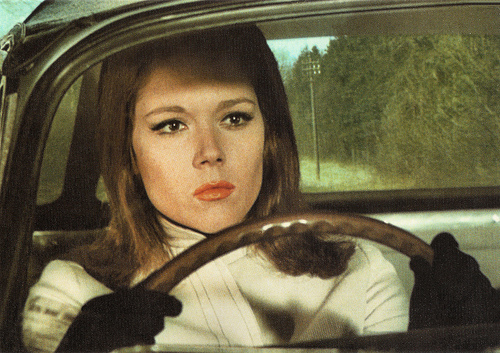
French postcard by Universal Collections, 2004. Photo: Canal+ Image UK Ltd. Publicity still for the TV series The Avengers (1965-1968), which was called in France Chapeau melon & Bottes de cuir.
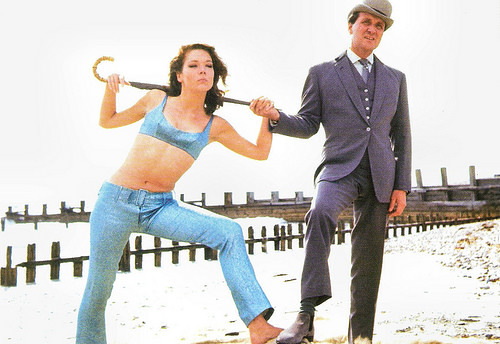
French postcard by Universal Collections, 2002. Photo: Canal+ Image UK Ltd. Publicity still for the TV series The Avengers (1965-1968), which was called in France Chapeau melon & Bottes de cuir.
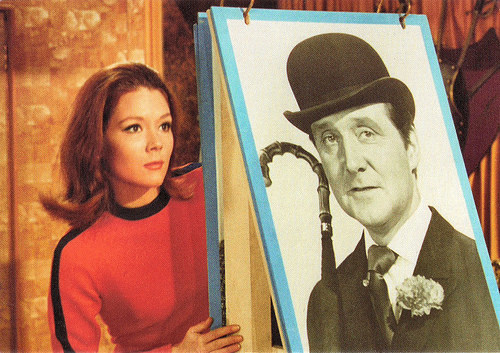
French postcard by Universal Collections, 2004. Photo: Canal+ Image UK Ltd. Publicity still for the TV series The Avengers (1965-1968), which was called in France Chapeau melon & Bottes de cuir.
Vincent Price’s loyal but homicidal daughter
In 1970, ‘ theatre animal’ Diana Rigg returned to the stage in the Ronald Millar play Abelard and Heloise in London. According to IMDb , she was the first major actor (along with co-star Keith Michell) to appear nude on stage in this production. She made her Broadway debut with the play in 1971, earning the first of three Tony Award nominations for Best Actress in a Play.
She received her second nomination in 1975, for The Misanthrope. A member of the National Theatre Company at the Old Vic from 1972 to 1975, Rigg took leading roles in premiere productions of two Tom Stoppard plays, Dorothy Moore in Jumpers (1972) and Ruth Carson in Night and Day (1978).
In the cinema she appeared in such films as the hilarious horror-comedy Theatre of Blood (Douglas Hickox, 1973) as Vincent Price’s loyal but homicidal daughter, and the disastrous musical A Little Night Music (Harold Prince, 1977), starring Elizabeth Taylor .
On television, she appeared as the title character in The Marquise (1980), a TV adaptation of play by Noël Coward. In 1981 she appeared on TV in the title role of Hedda Gabler, and in the cinema as Lady Holiday in The Great Muppet Caper (Jim Henson, 1981). The following year she received acclaim for her performance as glamorous actress Arlena Stuart Marshall in the film adaptation of Agatha Christie's Evil Under the Sun (Guy Hamilton, 1982), with Peter Ustinov as Hercule Poirot.
Craig Butler at AllMovie : “Diana Rigg and Maggie Smith in particular make scenery chewing seem the most natural way of acting in a movie. (Riggs' performance of You're the Top - constantly interrupted by Smith - is particularly memorable.)”
Also in 1982, Rigg published the hilarious book No Turn Unstoned, in which she gathered together the worst reviews ever received by the world's best actors. The book, which includes a review by New York Magazine’s John Simon with uncouth remarks about her nude scene in Abelard and Heloise, became a bestseller and cult favourite.
She appeared as Regan, the king's treacherous second daughter, in a TV production of King Lear (1983), featuring Laurence Olivier . She costarred with Denholm Elliot in a television version of Dickens' Bleak House (1985), and played the Evil Queen, Snow White's evil stepmother, in a film adaptation of Snow White (Michael Berz, 1987).
In 1987 she took a leading role in the West End production of Stephen Sondheim's musical Follies. Then Rigg played obsessive mother Helena Vesey, who was prepared to do anything, even murder, to keep control of her son in the TV Mini-series Mother Love (1989). For her role, she won the BAFTA TV Award for Best Actress. In 1988, Rigg was made a Commander of the Order of the British Empire (CBE) and in 1994, a Dame Commander of the Order of the British Empire (DBE).
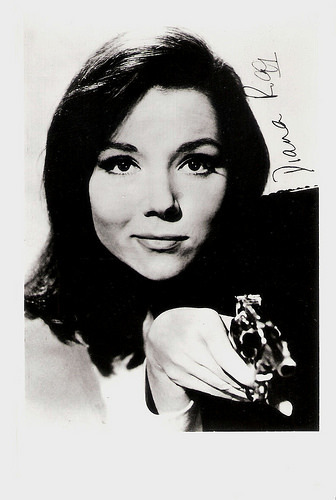
German postcard. Photo: ZDF. Publicity still for the TV series The Avengers (1965-1968), which was called in Germany Mit Schirm, Charm und Melone.
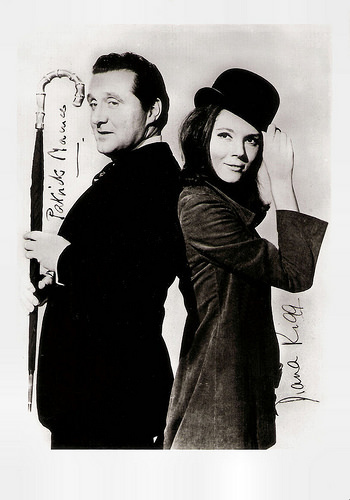
German postcard. Photo: ZDF. Publicity still for the TV series The Avengers (1965-1968), which was called in Germany Mit Schirm, Charm und Melone. Patrick Macnee was John Steed and Diana Rigg was Emma Peel.
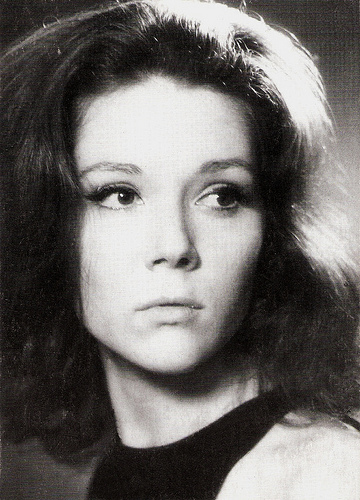
Danish postcard by Forlaget Holger Danske, no. 951.
The Queen of Thorns
In the 1990s, Diana Rigg had more triumphs on stage with her role as Medea at the Almeida Theatre in Islington in 1992. The production transferred in 1993 to the Wyndham's Theatre and in 1994 to Broadway. Rigg received the Tony Award for Best Actress for this performance. Other triumphs were her Mother Courage at the National Theatre in 1995 and Who's Afraid of Virginia Woolf? at the Almeida Theatre in 1996.
She won an Emmy Award for her role as the sinister Mrs. Danvers in Rebecca (Jim O’Brien, 1997). She also appeared in The Fortunes and Misfortunes of Moll Flanders (David Attwood, 1996), and as the eccentric old amateur detective Mrs. Bradley in The Mrs Bradley Mysteries (James Hawes, Martin Hutchings, 1998-2000).
On stage, Rigg appeared in 2004 as Violet Venable in Tennessee Williams' play Suddenly Last Summer, and in 2007 as Huma Rojo in All About My Mother, based on the film by Pedro Almodóvar. She played in 2008 in The Cherry Orchard, and in 2009 in Noël Coward's Hay Fever. In 2011 she played Mrs Higgins in Pygmalion, opposite Rupert Everett and Kara Tointon, having played Eliza Doolittle 37 years earlier at the Albery Theatre.
In the cinema she could be seen in as Grandmamma in the family film Heidi (Paul Marcus, 2005) and as a French Mother Superior who presides over a Chinese orphanage in The Painted Veil (John Curran, 2006) with Naomi Watts and Edward Norton.
In the 1960s, Rigg lived for eight years with actor/director Philip Saville. She was married to Menachem Gueffen, an Israeli painter, from 1973 until their divorce in 1976, and to Archibald Stirling, a theatrical producer and former officer in the Scots Guards, in 1982, until their divorce in 1990. With Stirling, Rigg has a daughter, actress Rachael Stirling (1977).
In 2013, she appeared with her daughter Rachel in the hit series Doctor Who in the episode The Crimson Horror (Saul Metzstein, 2013). The same year, Rigg secured a recurring role in the third season of the HBO series Game of Thrones (2013-present). She portrayed Lady Olenna Tyrell, a witty and sarcastic political mastermind popularly known as the Queen of Thorns, the grandmother of regular character Margaery Tyrell. Her performance was well received and earned her an Emmy nomination in 2013. She reprised her role in the seasons four, five and six, in an expanded role from the books.
In October 2015, to mark 50 years of Emma Peel, the BFI (British Film Institute) screened an episode of The Avengers followed by an onstage interview with Diana Rigg about her time on the cult 1960s TV show.
Official Trailer On Her Majesty's Secret Service (1969). Source: Movieclips Trailer Vault (YouTube).
Trailer Theatre Of Blood (1973). Source: Ian Hendry (YouTube).
Trailer Evil Under the Sun (1982). Source: jirluin (YouTube).
Sources: Stuart Jeffries (The Guardian), Hal Erickson (AllMovie), Donald Guarisco (AllMovie), Craig Butler (AllMovie), (IMDb), TCM, Wikipedia, and .

German postcard by Ludw. Povel & Co, Nordhorn.

French postcard by Universal Collections, 2002. Photo: Canal+ Image UK Ltd.

French postcard by Universal Collections, 2002. Photo: Canal+ Image UK Ltd.
Captivating little boys of all ages
Enid Diana Elizabeth Rigg was born in Doncaster, then in the West Riding of Yorkshire, now in South Yorkshire, in 1938. Her parents were railway engineer Louis Rigg and his wife Beryl Hilda Rigg née Helliwell. Between the ages of two months and eight years Rigg lived in Bikaner, India, where her father was employed as a railway executive.
She was then sent to a private boarding school, where she suffered through the discipline and rigours until one of her teachers introduced her to the world of the theatre. From 1955 till 1957, she trained as an actress at the Royal Academy of Dramatic Art, where Glenda Jackson and Siân Phillips were among her classmates.
Rigg made her professional stage debut in the RADA production of The Caucasian Chalk Circle at the York Festival in 1957. In 1959, she joined the Royal Shakespeare Company and stayed there till 1964. Her deeply distinctive voice, auburn red hair, and towering height (5'8") assured her such dynamic roles as Viola in Twelfth Night and Cordelia in King Lear.
In 1965, actress Elizabeth Shepherd was dropped from a popular BBC TV series after filming two episodes. Rigg auditioned for the role on a whim, without ever having seen the programme. Hal Erickson at AllMovie : “she was selected to replace Honor Blackman on the popular tongue-in-cheek TV-adventure series The Avengers and for the next two years captivated little boys of all ages with her energetic portrayal of coolheaded, leather-clad karate expert Mrs. Emma Peel.”
Fans were fond of the banter between Mrs. Peel and Patrick Macnee’s John Steed, delivered with champagne crispness. From 1965 till 1967, Rigg appeared in 51 episodes of the cult series. She became soured on the series when she discovered that she was earning less than some of the cameramen. After holding out for a pay raise, she returned for a second season, which would be her last.
Then film stardom followed. She became a Bond girl in On Her Majesty's Secret Service (Peter R. Hunt, 1969), playing Countess Teresa di Vicenzo a.k.a. Tracy Bond, 007's only wife, opposite George Lazenby. Although its cinema release was not as lucrative as its predecessor You Only Live Twice, On Her Majesty's Secret Service was still one of the top performing films of the year.
Critical reviews upon release were mixed, but the film's reputation has improved over time. Donald Guarisco at AllMovie : “Diana Rigg also makes a vivid impression as Tracy, easily the toughest and most resourceful of all Bond heroines”. Rigg’s other films from this period include her film debut A Midsummer Night's Dream (Peter Hall, 1968), the black comedy The Assassination Bureau (Basil Dearden, 1969) with Oliver Reed, Julius Caesar (Stuart Burge, 1970) featuring John Gielgud , and the satire The Hospital (Arthur Hiller, 1971). All her films were well regarded but no box office hits.

French postcard by Universal Collections, 2004. Photo: Canal+ Image UK Ltd. Publicity still for the TV series The Avengers (1965-1968), which was called in France Chapeau melon & Bottes de cuir.

French postcard by Universal Collections, 2002. Photo: Canal+ Image UK Ltd. Publicity still for the TV series The Avengers (1965-1968), which was called in France Chapeau melon & Bottes de cuir.

French postcard by Universal Collections, 2004. Photo: Canal+ Image UK Ltd. Publicity still for the TV series The Avengers (1965-1968), which was called in France Chapeau melon & Bottes de cuir.
Vincent Price’s loyal but homicidal daughter
In 1970, ‘ theatre animal’ Diana Rigg returned to the stage in the Ronald Millar play Abelard and Heloise in London. According to IMDb , she was the first major actor (along with co-star Keith Michell) to appear nude on stage in this production. She made her Broadway debut with the play in 1971, earning the first of three Tony Award nominations for Best Actress in a Play.
She received her second nomination in 1975, for The Misanthrope. A member of the National Theatre Company at the Old Vic from 1972 to 1975, Rigg took leading roles in premiere productions of two Tom Stoppard plays, Dorothy Moore in Jumpers (1972) and Ruth Carson in Night and Day (1978).
In the cinema she appeared in such films as the hilarious horror-comedy Theatre of Blood (Douglas Hickox, 1973) as Vincent Price’s loyal but homicidal daughter, and the disastrous musical A Little Night Music (Harold Prince, 1977), starring Elizabeth Taylor .
On television, she appeared as the title character in The Marquise (1980), a TV adaptation of play by Noël Coward. In 1981 she appeared on TV in the title role of Hedda Gabler, and in the cinema as Lady Holiday in The Great Muppet Caper (Jim Henson, 1981). The following year she received acclaim for her performance as glamorous actress Arlena Stuart Marshall in the film adaptation of Agatha Christie's Evil Under the Sun (Guy Hamilton, 1982), with Peter Ustinov as Hercule Poirot.
Craig Butler at AllMovie : “Diana Rigg and Maggie Smith in particular make scenery chewing seem the most natural way of acting in a movie. (Riggs' performance of You're the Top - constantly interrupted by Smith - is particularly memorable.)”
Also in 1982, Rigg published the hilarious book No Turn Unstoned, in which she gathered together the worst reviews ever received by the world's best actors. The book, which includes a review by New York Magazine’s John Simon with uncouth remarks about her nude scene in Abelard and Heloise, became a bestseller and cult favourite.
She appeared as Regan, the king's treacherous second daughter, in a TV production of King Lear (1983), featuring Laurence Olivier . She costarred with Denholm Elliot in a television version of Dickens' Bleak House (1985), and played the Evil Queen, Snow White's evil stepmother, in a film adaptation of Snow White (Michael Berz, 1987).
In 1987 she took a leading role in the West End production of Stephen Sondheim's musical Follies. Then Rigg played obsessive mother Helena Vesey, who was prepared to do anything, even murder, to keep control of her son in the TV Mini-series Mother Love (1989). For her role, she won the BAFTA TV Award for Best Actress. In 1988, Rigg was made a Commander of the Order of the British Empire (CBE) and in 1994, a Dame Commander of the Order of the British Empire (DBE).

German postcard. Photo: ZDF. Publicity still for the TV series The Avengers (1965-1968), which was called in Germany Mit Schirm, Charm und Melone.

German postcard. Photo: ZDF. Publicity still for the TV series The Avengers (1965-1968), which was called in Germany Mit Schirm, Charm und Melone. Patrick Macnee was John Steed and Diana Rigg was Emma Peel.

Danish postcard by Forlaget Holger Danske, no. 951.
The Queen of Thorns
In the 1990s, Diana Rigg had more triumphs on stage with her role as Medea at the Almeida Theatre in Islington in 1992. The production transferred in 1993 to the Wyndham's Theatre and in 1994 to Broadway. Rigg received the Tony Award for Best Actress for this performance. Other triumphs were her Mother Courage at the National Theatre in 1995 and Who's Afraid of Virginia Woolf? at the Almeida Theatre in 1996.
She won an Emmy Award for her role as the sinister Mrs. Danvers in Rebecca (Jim O’Brien, 1997). She also appeared in The Fortunes and Misfortunes of Moll Flanders (David Attwood, 1996), and as the eccentric old amateur detective Mrs. Bradley in The Mrs Bradley Mysteries (James Hawes, Martin Hutchings, 1998-2000).
On stage, Rigg appeared in 2004 as Violet Venable in Tennessee Williams' play Suddenly Last Summer, and in 2007 as Huma Rojo in All About My Mother, based on the film by Pedro Almodóvar. She played in 2008 in The Cherry Orchard, and in 2009 in Noël Coward's Hay Fever. In 2011 she played Mrs Higgins in Pygmalion, opposite Rupert Everett and Kara Tointon, having played Eliza Doolittle 37 years earlier at the Albery Theatre.
In the cinema she could be seen in as Grandmamma in the family film Heidi (Paul Marcus, 2005) and as a French Mother Superior who presides over a Chinese orphanage in The Painted Veil (John Curran, 2006) with Naomi Watts and Edward Norton.
In the 1960s, Rigg lived for eight years with actor/director Philip Saville. She was married to Menachem Gueffen, an Israeli painter, from 1973 until their divorce in 1976, and to Archibald Stirling, a theatrical producer and former officer in the Scots Guards, in 1982, until their divorce in 1990. With Stirling, Rigg has a daughter, actress Rachael Stirling (1977).
In 2013, she appeared with her daughter Rachel in the hit series Doctor Who in the episode The Crimson Horror (Saul Metzstein, 2013). The same year, Rigg secured a recurring role in the third season of the HBO series Game of Thrones (2013-present). She portrayed Lady Olenna Tyrell, a witty and sarcastic political mastermind popularly known as the Queen of Thorns, the grandmother of regular character Margaery Tyrell. Her performance was well received and earned her an Emmy nomination in 2013. She reprised her role in the seasons four, five and six, in an expanded role from the books.
In October 2015, to mark 50 years of Emma Peel, the BFI (British Film Institute) screened an episode of The Avengers followed by an onstage interview with Diana Rigg about her time on the cult 1960s TV show.
Official Trailer On Her Majesty's Secret Service (1969). Source: Movieclips Trailer Vault (YouTube).
Trailer Theatre Of Blood (1973). Source: Ian Hendry (YouTube).
Trailer Evil Under the Sun (1982). Source: jirluin (YouTube).
Sources: Stuart Jeffries (The Guardian), Hal Erickson (AllMovie), Donald Guarisco (AllMovie), Craig Butler (AllMovie), (IMDb), TCM, Wikipedia, and .
Published on October 07, 2016 22:00
October 6, 2016
EFSP's Dazzling Dozen: Ceci n'est pas un pipe
A smoking pipe is a device made to allow the user to inhale or taste smoke or vapor derived from the burning or vaporization of some substance. The most common form of these is the tobacco pipe, which is designed for use with tobacco, although the device itself may be used with other substances. Did you lately see a star smoke a pipe? Probably not. The postcards in today's post prove once again that times are changing...
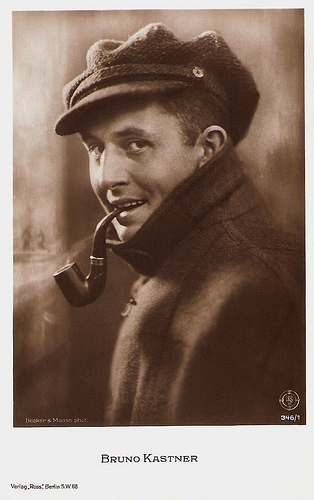
German postcard by Ross Verlag, no. 346/1, 1919-1924. Photo: Becker & Maass / RF.
German actor Bruno Kastner (1890-1932) was one of the most beloved stars of the 1910s and 1920s. His parts as the elegant and charming dandy made him a heart throb of the German silent cinema.
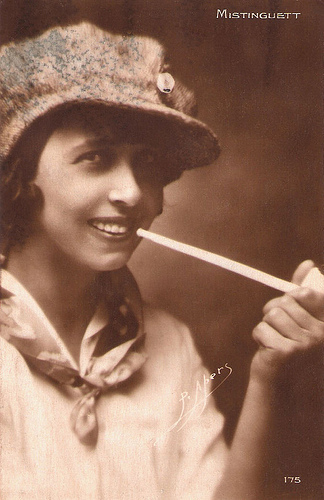
French postcard by Cinémagazine-Edition, Paris, no. 175. Photo: P. Apers.
French actress and singer Mistinguett (1875-1956) captivated Paris with her risqué routines. She went on to become the most popular French entertainer of her time and the highest paid female entertainer in the world. She appeared more than 60 times in the cinema.
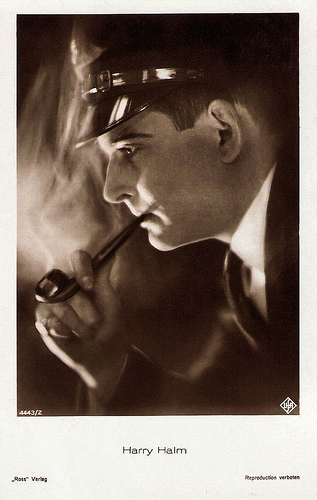
German postcard by Ross Verlag, no. 4443/2, 1929-1930. Photo: Ufa.
Charming actor Harry Halm (1901-1980) was a popular ladies’ man of the silent German cinema. Sound film and the rise of the Nazis broke his career.

German postcard by Ross Verlag, no. 5680/1, 1930-1931. Photo: Aafa-Film. Publicity still for Stürme über dem Mont Blanc/Storm Over Mont Blanc (Arnold Fanck, 1930).
Sepp Rist (1900-1980) was a top skier, who was spotted for the Mountain films by Arnold Fanck. Later the Athletic German actor with the typical tanned and weathered face played, hunters, foresters and other rugged characters in several Heimat films.
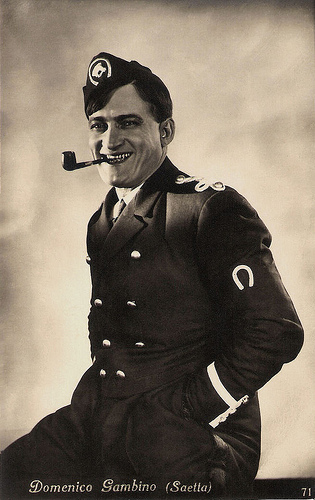
Italian postcard by Ed. A. Traldi, Milano, no. 71. Card perhaps for Caporal Saetta (Eugenio Perego, 1924).
Domenico Maria Gambino (1891-1968) was an Italian actor, director, scriptwriter and producer. He was well-known as the acrobatic comedian Saetta and often directed his own films.
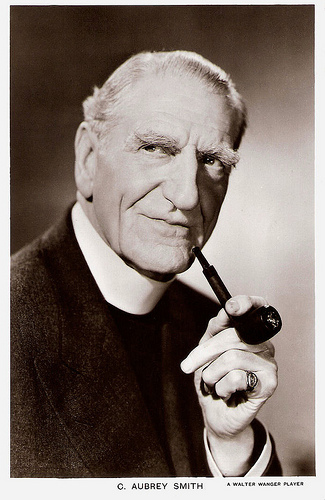
British postcard in the Picturegoer Series, London, no. 790A. Photo: Walter Wanger.
C. Aubrey Smith (1863–1948) was an English cricketer and actor, who started his film career in the British silent cinema. He went to Hollywood where he had a successful career as a character actor playing stereotypical Englishmen with the stiff upper lip and a stern determination. His bushy eyebrows, beady eyes, and handlebar moustache made him one of the most recognisable faces in Hollywood.

Big card by Ross Verlag. Photo: Ufa / Hämmerer.
Jovial, pleasantly plump Hans Albers (1891–1960) was a superstar of the German cinema between 1930 and 1945. He was also one of the most popular German singers of the twentieth century. His song Auf der Reeperbahn nachts um halb eins (On the Reeperbahn at half past midnight) is the unofficial anthem of Hamburg’s neighborhood of St. Pauli, famous for its brothels, music and night clubs.

German postcard by Film-Foto-Verlag, no. 3647/1, 1941-1944. Photo: Lindner / Terra.
Huge, bear-like Heinrich George (1893–1946) was a famous German stage and film actor of the Weimar republic. He starred in such classics as Metropolis (1926) and Berlin Alexanderplatz (1931). Under the Nazi regime, the former Communist was initially not permitted to work but later appeared in notorious propaganda films as Jud Süss (1940). After the war he died of starvation in a Soviet concentration camp.

French postcard by Editions du Globe, Paris, no. 795. Photo: Studio Harcourt.
French actor Michel Piccoli (1925) has appeared in many different roles, from seducer to cop to gangster to Pope in more than 200 films and TV films. Among the directors he worked with are Jean Renoir, Jean-Pierre Melville, Jean-Luc Godard, Agnès Varda, Luis Buñuel, and Alfred Hitchcock.

German postcard by Kunst und Bild, Berlin, no. A 1001. Photo: Berolina / Constantin / Wesel. Publicity still for Hurra - ein Junge/Hooray - a boy! (Ernst Marischka, Georg Jacoby, 1953).
Austrian actor Walter Müller (1911-1969) was a popular star of the operettas on stage and in the cinema. In the 1940s he appeared as the Sonny Boy of many German films and in the early 1950s he often played the friend or competitor of the real hero.
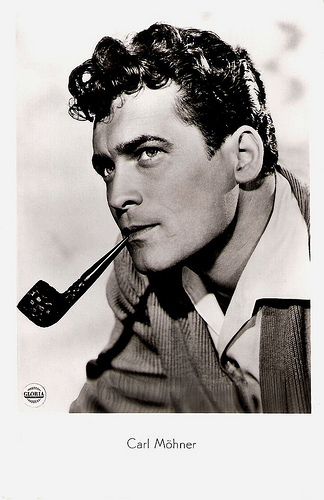
German postcard by F.J. Rüdel, Hamburg-Bergedorf. Photo: Gloria.
Handsome Austrian film actor Carl Möhner (1921–2005) appeared in over 40 films between 1949 and 1976, including the French gangster classic Du rififi chez les hommes/Rififi (1955).

German postcard by Ufa, Berlin-Tempelhof, no. FK 1888. Photo: Eva-Film / RKO-Film. Publicity still for Solange Du Lebst/As Long as You Live (Harald Reinl, 1955).
Austrian actor Adrian Hoven (1922-1981) was the athletic and dynamic Sonnyboy of the German cinema in the 1950s, who would become one of the stars of Rainer Werner Fassbinder's films in the 1970s. As a writer, producer and director he made horror and erotica with SM overtones.
Source: Wikipedia.

German postcard by Ross Verlag, no. 346/1, 1919-1924. Photo: Becker & Maass / RF.
German actor Bruno Kastner (1890-1932) was one of the most beloved stars of the 1910s and 1920s. His parts as the elegant and charming dandy made him a heart throb of the German silent cinema.

French postcard by Cinémagazine-Edition, Paris, no. 175. Photo: P. Apers.
French actress and singer Mistinguett (1875-1956) captivated Paris with her risqué routines. She went on to become the most popular French entertainer of her time and the highest paid female entertainer in the world. She appeared more than 60 times in the cinema.

German postcard by Ross Verlag, no. 4443/2, 1929-1930. Photo: Ufa.
Charming actor Harry Halm (1901-1980) was a popular ladies’ man of the silent German cinema. Sound film and the rise of the Nazis broke his career.

German postcard by Ross Verlag, no. 5680/1, 1930-1931. Photo: Aafa-Film. Publicity still for Stürme über dem Mont Blanc/Storm Over Mont Blanc (Arnold Fanck, 1930).
Sepp Rist (1900-1980) was a top skier, who was spotted for the Mountain films by Arnold Fanck. Later the Athletic German actor with the typical tanned and weathered face played, hunters, foresters and other rugged characters in several Heimat films.

Italian postcard by Ed. A. Traldi, Milano, no. 71. Card perhaps for Caporal Saetta (Eugenio Perego, 1924).
Domenico Maria Gambino (1891-1968) was an Italian actor, director, scriptwriter and producer. He was well-known as the acrobatic comedian Saetta and often directed his own films.

British postcard in the Picturegoer Series, London, no. 790A. Photo: Walter Wanger.
C. Aubrey Smith (1863–1948) was an English cricketer and actor, who started his film career in the British silent cinema. He went to Hollywood where he had a successful career as a character actor playing stereotypical Englishmen with the stiff upper lip and a stern determination. His bushy eyebrows, beady eyes, and handlebar moustache made him one of the most recognisable faces in Hollywood.

Big card by Ross Verlag. Photo: Ufa / Hämmerer.
Jovial, pleasantly plump Hans Albers (1891–1960) was a superstar of the German cinema between 1930 and 1945. He was also one of the most popular German singers of the twentieth century. His song Auf der Reeperbahn nachts um halb eins (On the Reeperbahn at half past midnight) is the unofficial anthem of Hamburg’s neighborhood of St. Pauli, famous for its brothels, music and night clubs.

German postcard by Film-Foto-Verlag, no. 3647/1, 1941-1944. Photo: Lindner / Terra.
Huge, bear-like Heinrich George (1893–1946) was a famous German stage and film actor of the Weimar republic. He starred in such classics as Metropolis (1926) and Berlin Alexanderplatz (1931). Under the Nazi regime, the former Communist was initially not permitted to work but later appeared in notorious propaganda films as Jud Süss (1940). After the war he died of starvation in a Soviet concentration camp.

French postcard by Editions du Globe, Paris, no. 795. Photo: Studio Harcourt.
French actor Michel Piccoli (1925) has appeared in many different roles, from seducer to cop to gangster to Pope in more than 200 films and TV films. Among the directors he worked with are Jean Renoir, Jean-Pierre Melville, Jean-Luc Godard, Agnès Varda, Luis Buñuel, and Alfred Hitchcock.

German postcard by Kunst und Bild, Berlin, no. A 1001. Photo: Berolina / Constantin / Wesel. Publicity still for Hurra - ein Junge/Hooray - a boy! (Ernst Marischka, Georg Jacoby, 1953).
Austrian actor Walter Müller (1911-1969) was a popular star of the operettas on stage and in the cinema. In the 1940s he appeared as the Sonny Boy of many German films and in the early 1950s he often played the friend or competitor of the real hero.

German postcard by F.J. Rüdel, Hamburg-Bergedorf. Photo: Gloria.
Handsome Austrian film actor Carl Möhner (1921–2005) appeared in over 40 films between 1949 and 1976, including the French gangster classic Du rififi chez les hommes/Rififi (1955).

German postcard by Ufa, Berlin-Tempelhof, no. FK 1888. Photo: Eva-Film / RKO-Film. Publicity still for Solange Du Lebst/As Long as You Live (Harald Reinl, 1955).
Austrian actor Adrian Hoven (1922-1981) was the athletic and dynamic Sonnyboy of the German cinema in the 1950s, who would become one of the stars of Rainer Werner Fassbinder's films in the 1970s. As a writer, producer and director he made horror and erotica with SM overtones.
Source: Wikipedia.
Published on October 06, 2016 22:00
October 5, 2016
Danielle Darrieux
French actress and singer Danielle Darrieux (1917) is an enduringly beautiful, international leading lady whose eight-decade career is among the longest in film history. From her film debut in 1931 on she played in more than 110 films in which she progressed from playing pouty teens to worldy sophisticates. In the early 1950s she starred in three classic films by Max Ophüls, and she played the mother of Catherine Deneuve in five films!
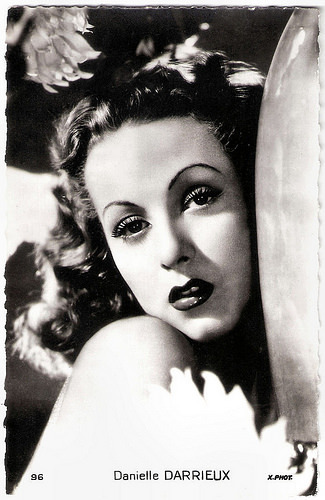
French postcard by Edition Chantal, Rueil, no. 96. Photo: x.phot.
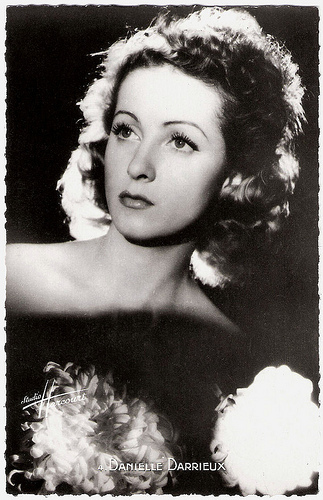
French postcard by S.E.R.P., Paris, no. 4. Photo: Studio Harcourt.
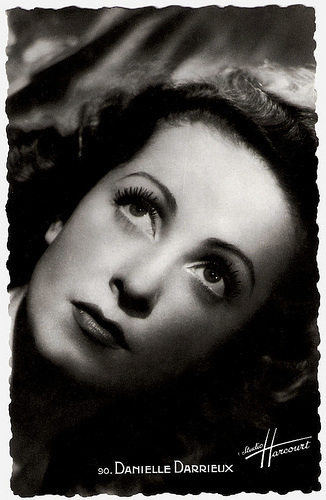
French postcard by SERP, Paris, no. 90. Photo: Studio Harcourt.
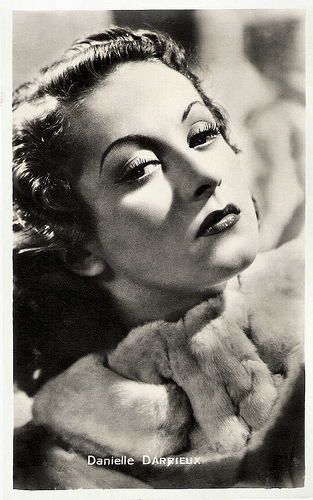
Dutch postcard.
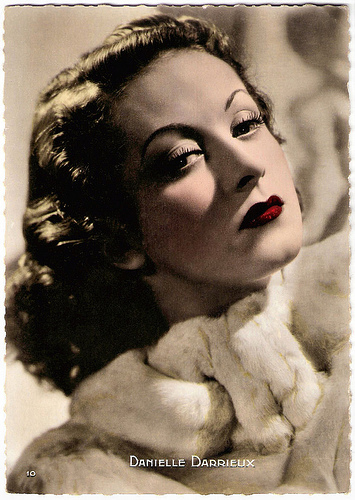
French postcard by Editions P.I., Paris, no. 10.
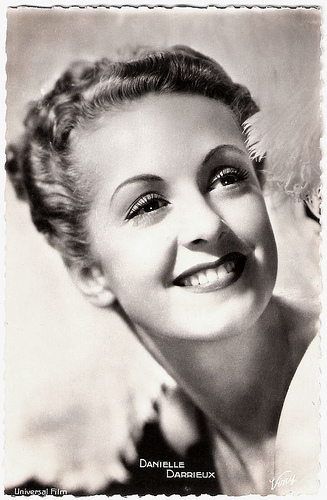
French postcard by Viny, no. 70. Photo: Universal Film.
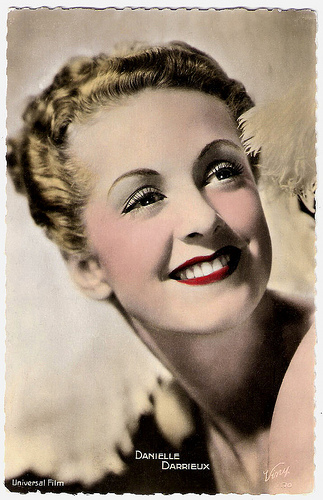
French postcard by Viny, no. 70. Photo: Universal Film.
Romantic Lead
Danielle Yvonne Marie Antoinette Darrieux was born in Bordeaux, France in 1917, but she was raised in Paris. She was the daughter of an army doctor who died when she was seven years old. Her brother is actor Olivier Darrieux.
Her family were keen music enthusiasts and Danielle studied the cello and piano at the Conservatoire de Musique (the Paris Conservatory). When she was only 14 she auditioned for a secondary role in the musical film Le Bal/The Ball (Wilhelm Thiele, 1931). Her beauty combined with her singing and dancing abilities got her the part.
Her performance as a headstrong teenager was impressive and the producer offered her a five-year contract. Her first romantic lead was in the backstage comedy La Crise est finie/The crisis is finished (Robert Siodmak, 1934) with Albert Préjean .
She scored an international hit with the historical love-drama Mayerling (Anatole Litvak, 1936) in which she played doomed Baroness Marie Vetsera opposite Charles Boyer as Archduke Rudolph of Austria.
In 1935, Darrieux married director/screenwriter Henri Decoin, and they made six films together in the following years like Abus de Confiance/Abused Confidence (Henri Decoin, 1938) with Charles Vanel . Decoin encouraged her to try Hollywood, and in 1938 she signed with studio executive Joe Pasternak from Universal Studios to appear in the comedy The Rage of Paris (Henry Koster, 1938) opposite Douglas Fairbanks, Jr.
Both the film and Darrieux were well-received, but her stay in Hollywood proved short-lived. She quickly returned to Paris, where she continued to star in such major hits as Battement de coeur/Beating Heart (Henri Decoin, 1940) with Claude Dauphin .
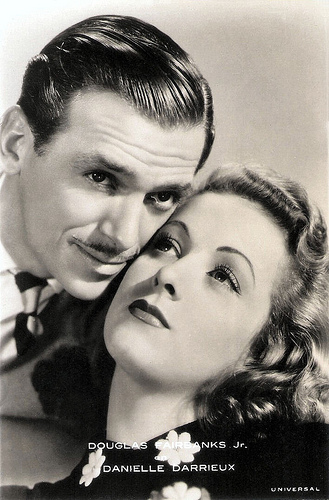
Dutch postcard by Sparo. Photo: Universal. Publicity still for The Rage of Paris (Henry Koster, 1938) with Douglas Fairbanks Jr.
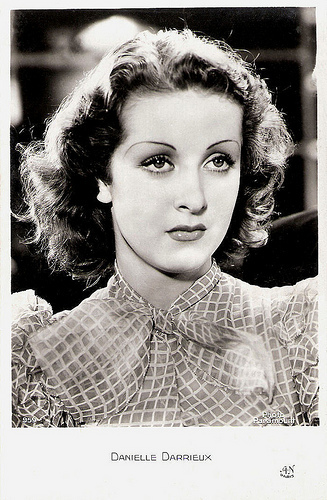
French postcard by A.N., Paris, no. 959. Photo: Paramount.
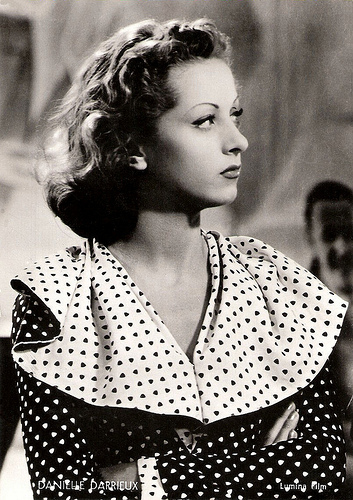
Dutch postcard by J.S.A. (J. Sleding, Amsterdam), no. 640/516. Photo: Lumina Film.
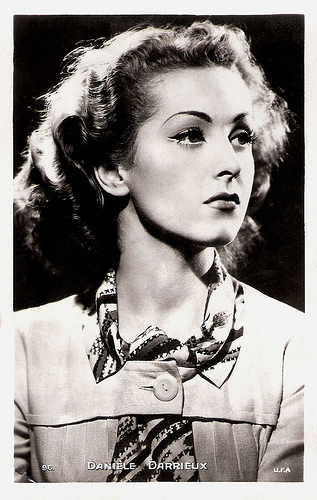
French postcard, no. 96. Photo: UFA.
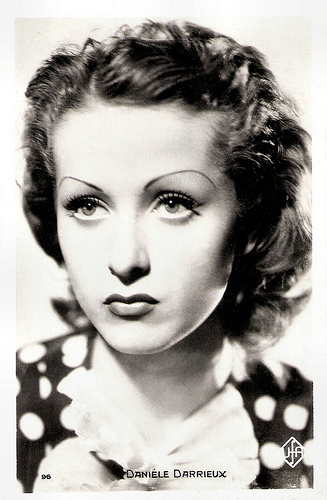
French postcard by Editions Chantal, no. 96. Photo: UFA.
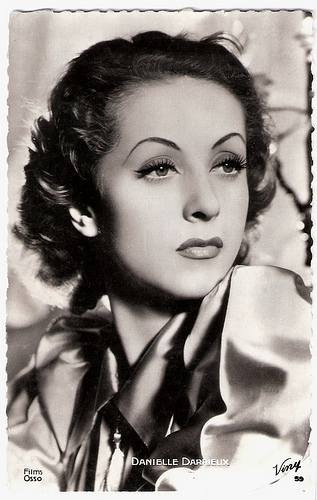
French postcard by Viny, no. 59. Photo: Films Osso.
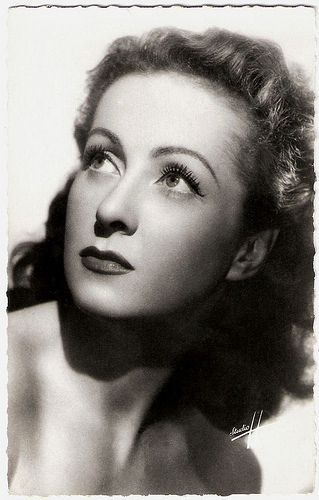
French postcard by Editions O.P., Paris, no. 1. Photo: Studio Harcourt.
German Occupation
After the occupation of France, Danielle Darrieux found herself working under the scrutiny of the new Nazi regime. She became the leading light of Continental, a Franco-German film company which was closely scrutinised by the Nazis. She distinguished herself in films such as Premier Rendez-Vous/Her First Affair (Henri Decoin, 1941).
After a visit to Germany, where she entertained the German troops, Darrieux’s popularity in France immediately plummeted and her name was placed on a death-list of the French Resistance. Even when her death sentence was lifted after the war, it was several years before she had regained her former popularity.
After the war, she explained that Alfred Greven, the manager of Continental, had threatened to deport her brother Olivier to Germany. After her divorce from Henri Decoin in 1941, she had married Dominican Republic diplomat and international jet-setter Porfirio Rubirosa in 1942. His anti-Nazi opinions resulted in his forced residence in Germany. Darrieux had accepted the promotional trip to Berlin in exchange for Rubirosa's liberation. They lived in Switzerland until the end of the war, and divorced in 1947.
A year later she married script-writer George Mitsikides and lived with him until his death in 1991. Her grand return came in 1949 with Claude Autant-Lara’s period farce Occupe-toi d'Amélie/Keep an Eye on Amelia (Claude Autant-Lara, 1949).
After La Ronde/Roundabout (Max Ophüls, 1950), Danielle Darrieux returned to Hollywood to appear as a French chanteuse in the MGM musical Rich, Young and Pretty (Norman Taurog, 1951) with Jane Powell. Joseph L. Mankiewicz then lured her to play the duplicitous lady friend of James Mason in the thriller 5 Fingers (Joseph L. Mankiewicz, 1952).
Back home, she starred in Le Plaisir/Pleasure (Max Ophüls, 1952) with Madeleine Renaud , and opposite Charles Boyer and Vittorio de Sica in Madame de....../Diamond Earrings (Max Ophüls, 1953).
James Travers at Le Film Guide observes: "The 1950's saw a marked change in Darrieux on-screen persona. She was no longer the care-free ingenue of her pre-war years. She had become a sophisticated and passionate society woman, often appearing cold and calculating, but sometimes showing a tender tragic vulnerability. The film which defined Danielle Darrieux in this period was Madame de… (1953), in which she gave probably her best screen performance. This was the third of three films she appeared in which were directed by her fond admirer Max Ophüls."
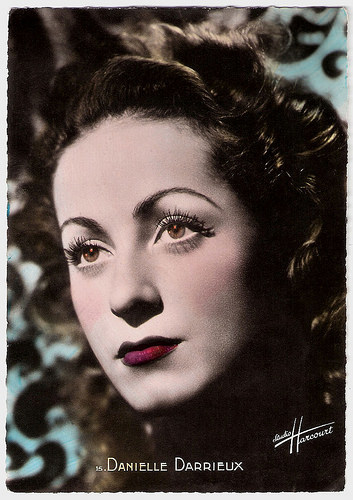
French postcard by S.E.R.P., Paris, no. 15. Photo: Studio Harcourt.
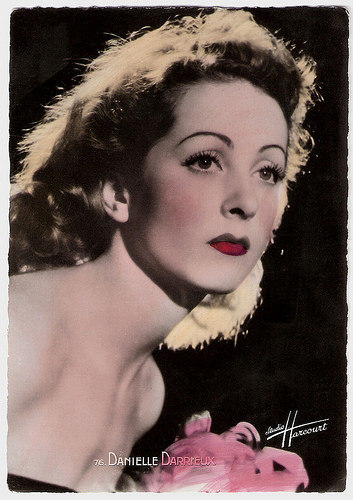
French postcard by S.E.R.P., Paris, no. 76. Photo: Studio Harcourt.
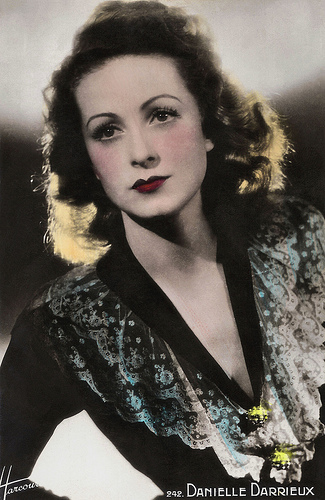
French postcard by S.E.R.P., Paris, no. 242. Photo: Studio Harcourt.
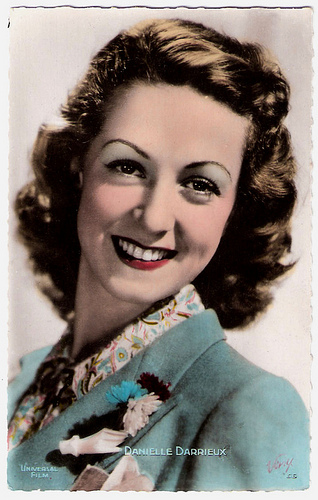
French postcard by Viny, no. 56. Photo: Universal Film.
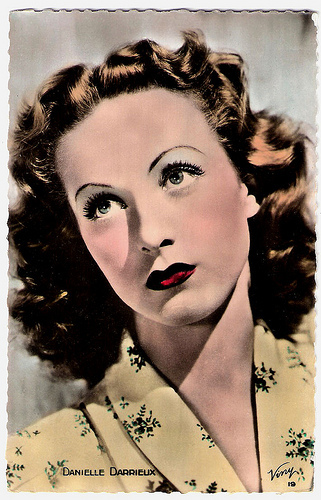
French postcard by Viny, no. 19.
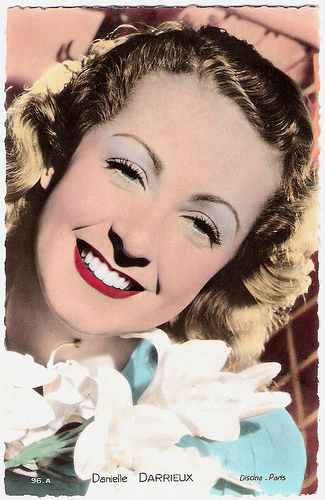
French postcard by Collection Chantal, Paris, no. 96 A. Photo: Discina, Paris.
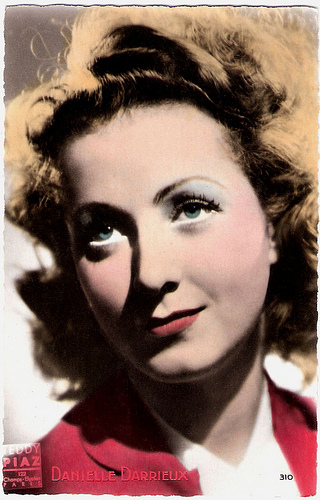
French postcard by Editions O.P., Paris, no. 310. Photo: Teddy Piaz, Paris.
Lady Chatterley's Lover
During the 1950s, Danielle Darrieux also appeared in Le rouge et le noir/The Red and the Black (Claude Autant-Lara, 1954) opposite Gérard Philipe , and in L’amant de Lady Chatterley/Lady Chatterley's Lover (Marc Allégret, 1955) with Leo Genn . Due to its content, the latter film was banned by the Catholic censors in the United States.
She also played a supporting role in United Artists' epic Alexander the Great (Robert Rossen, 1957) starring Richard Burton . It was her last Hollywood production. Since then she has continued to work in the European cinema.
In England she starred opposite Kenneth More in The Greengage Summer (Lewis Gilbert, 1961), and in France she appeared as the mother of Catherine Deneuve in five films: L’Homme à femmes/Ladies Man (Jacques Gérard Cornu, 1960), the classic musical Les Demoiselles de Rochefort/The Young Girls of Rochefort (Jacques Demy, 1967), the drama Le Lieu du crime/Scene of the Crime (André Téchiné, 1986), the comedy-murder-mystery 8 femmes/8 Women (François Ozon, 2002), and most recently in Persepolis (Marjane Satrapi, 2007). This remarkable animated feature is based on a graphic novel of the same name about the impact of the Iranian Islamic revolution on a girl's life as she grows to adulthood.
The actress sang in concerts and cabarets in the 1960s, and in 1970 replaced Katharine Hepburn in the Broadway musical Coco. In the 1980s, Danielle Darrieux scored a significant success in a Paris staging of the film musical Gigi.
For her long service to the motion picture industry, she was given an Honorary César Award in 1985. Her most recent film is Pièce montée/The Wedding Cake (Denys Granier-Deferre, 2010) with Jérémie Renier. D.B. DuMonteil at IMDb : "Pièce Montée (tiered cake)is a funny comedy,with some nostalgia and an attack on the bourgeoisie Chabrol would not disown. Its depiction of a wedding in France is marvelously precise, with all these smug people, wearing their Sunday's best, and taking photographs of each other."
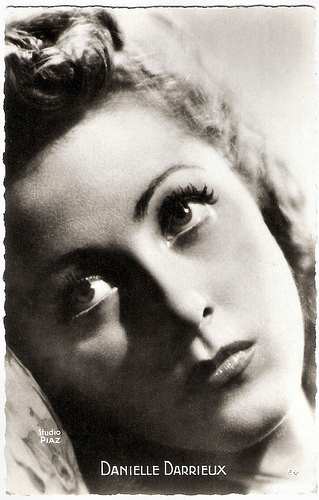
French postcard by Editions O.P., Paris, no. 54. Photo: Studio Piaz.
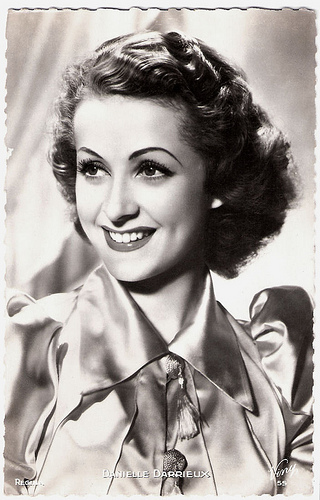
French postcard by Viny, no. 55. Photo: Regina.
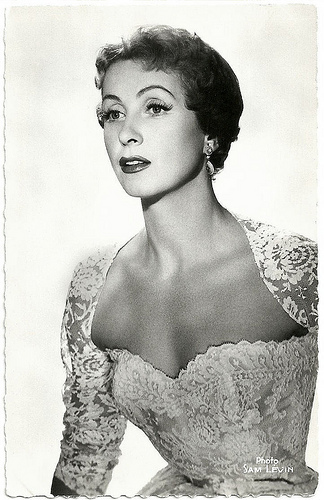
French postcard by Editions du Globe, Paris. Photo Sam Lévin.
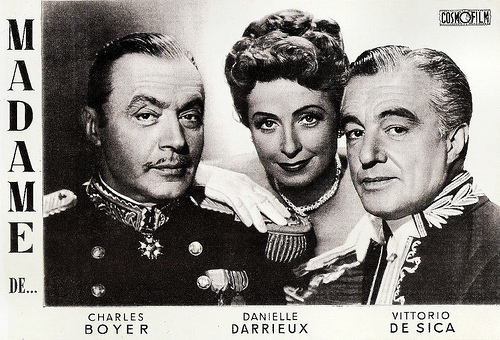
Spanish promotion card by Cosmofilm. Photo: publicity still for Madame de... (Max Ophüls, 1953) with Charles Boyer and Vittorio De Sica.
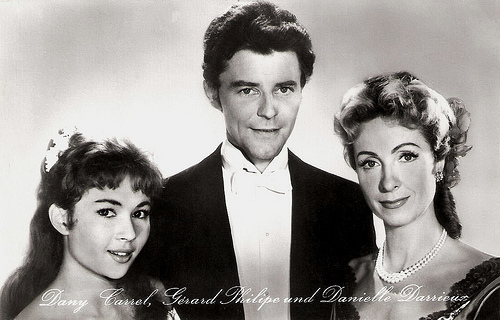
East-German postcard by VEB Progress Filmvertrieb, no. 1294, 1960. Photo: publicity still for Pot-Bouille/Lovers of Paris (Julien Duvivier, 1957) with Dany Carrel and Gérard Philipe.
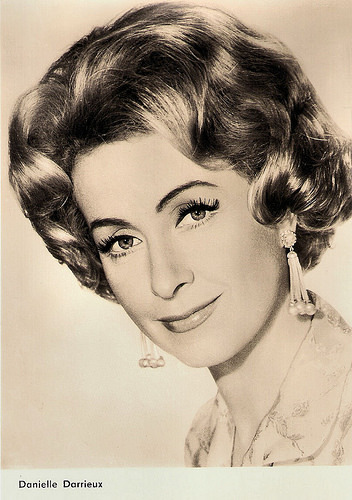
East-German postcard by VEB Progress Filmvertrieb, no. 2715, 1966.
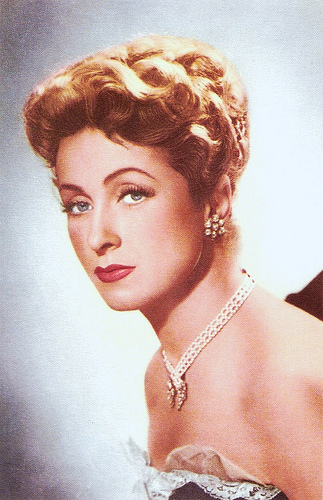
Vintage collectors card.
>
Scene from Madame De... (1953). Source: Classic Movies (YouTube).
Trailer of Les Demoiselles de Rochefort (1967). Source: British Film Institute (YouTube).
Trailer 8 femmes/8 Women (2002). Source: 2663KinkyCyborg (YouTube).
Sources: James Travers (Le Film Guide), Hal Erickson (All Movie), (IMDb), D.B. DuMonteil (IMDb), (TCM), AlloCiné (French), Wikipedia, and .

French postcard by Edition Chantal, Rueil, no. 96. Photo: x.phot.

French postcard by S.E.R.P., Paris, no. 4. Photo: Studio Harcourt.

French postcard by SERP, Paris, no. 90. Photo: Studio Harcourt.

Dutch postcard.

French postcard by Editions P.I., Paris, no. 10.

French postcard by Viny, no. 70. Photo: Universal Film.

French postcard by Viny, no. 70. Photo: Universal Film.
Romantic Lead
Danielle Yvonne Marie Antoinette Darrieux was born in Bordeaux, France in 1917, but she was raised in Paris. She was the daughter of an army doctor who died when she was seven years old. Her brother is actor Olivier Darrieux.
Her family were keen music enthusiasts and Danielle studied the cello and piano at the Conservatoire de Musique (the Paris Conservatory). When she was only 14 she auditioned for a secondary role in the musical film Le Bal/The Ball (Wilhelm Thiele, 1931). Her beauty combined with her singing and dancing abilities got her the part.
Her performance as a headstrong teenager was impressive and the producer offered her a five-year contract. Her first romantic lead was in the backstage comedy La Crise est finie/The crisis is finished (Robert Siodmak, 1934) with Albert Préjean .
She scored an international hit with the historical love-drama Mayerling (Anatole Litvak, 1936) in which she played doomed Baroness Marie Vetsera opposite Charles Boyer as Archduke Rudolph of Austria.
In 1935, Darrieux married director/screenwriter Henri Decoin, and they made six films together in the following years like Abus de Confiance/Abused Confidence (Henri Decoin, 1938) with Charles Vanel . Decoin encouraged her to try Hollywood, and in 1938 she signed with studio executive Joe Pasternak from Universal Studios to appear in the comedy The Rage of Paris (Henry Koster, 1938) opposite Douglas Fairbanks, Jr.
Both the film and Darrieux were well-received, but her stay in Hollywood proved short-lived. She quickly returned to Paris, where she continued to star in such major hits as Battement de coeur/Beating Heart (Henri Decoin, 1940) with Claude Dauphin .

Dutch postcard by Sparo. Photo: Universal. Publicity still for The Rage of Paris (Henry Koster, 1938) with Douglas Fairbanks Jr.

French postcard by A.N., Paris, no. 959. Photo: Paramount.

Dutch postcard by J.S.A. (J. Sleding, Amsterdam), no. 640/516. Photo: Lumina Film.

French postcard, no. 96. Photo: UFA.

French postcard by Editions Chantal, no. 96. Photo: UFA.

French postcard by Viny, no. 59. Photo: Films Osso.

French postcard by Editions O.P., Paris, no. 1. Photo: Studio Harcourt.
German Occupation
After the occupation of France, Danielle Darrieux found herself working under the scrutiny of the new Nazi regime. She became the leading light of Continental, a Franco-German film company which was closely scrutinised by the Nazis. She distinguished herself in films such as Premier Rendez-Vous/Her First Affair (Henri Decoin, 1941).
After a visit to Germany, where she entertained the German troops, Darrieux’s popularity in France immediately plummeted and her name was placed on a death-list of the French Resistance. Even when her death sentence was lifted after the war, it was several years before she had regained her former popularity.
After the war, she explained that Alfred Greven, the manager of Continental, had threatened to deport her brother Olivier to Germany. After her divorce from Henri Decoin in 1941, she had married Dominican Republic diplomat and international jet-setter Porfirio Rubirosa in 1942. His anti-Nazi opinions resulted in his forced residence in Germany. Darrieux had accepted the promotional trip to Berlin in exchange for Rubirosa's liberation. They lived in Switzerland until the end of the war, and divorced in 1947.
A year later she married script-writer George Mitsikides and lived with him until his death in 1991. Her grand return came in 1949 with Claude Autant-Lara’s period farce Occupe-toi d'Amélie/Keep an Eye on Amelia (Claude Autant-Lara, 1949).
After La Ronde/Roundabout (Max Ophüls, 1950), Danielle Darrieux returned to Hollywood to appear as a French chanteuse in the MGM musical Rich, Young and Pretty (Norman Taurog, 1951) with Jane Powell. Joseph L. Mankiewicz then lured her to play the duplicitous lady friend of James Mason in the thriller 5 Fingers (Joseph L. Mankiewicz, 1952).
Back home, she starred in Le Plaisir/Pleasure (Max Ophüls, 1952) with Madeleine Renaud , and opposite Charles Boyer and Vittorio de Sica in Madame de....../Diamond Earrings (Max Ophüls, 1953).
James Travers at Le Film Guide observes: "The 1950's saw a marked change in Darrieux on-screen persona. She was no longer the care-free ingenue of her pre-war years. She had become a sophisticated and passionate society woman, often appearing cold and calculating, but sometimes showing a tender tragic vulnerability. The film which defined Danielle Darrieux in this period was Madame de… (1953), in which she gave probably her best screen performance. This was the third of three films she appeared in which were directed by her fond admirer Max Ophüls."

French postcard by S.E.R.P., Paris, no. 15. Photo: Studio Harcourt.

French postcard by S.E.R.P., Paris, no. 76. Photo: Studio Harcourt.

French postcard by S.E.R.P., Paris, no. 242. Photo: Studio Harcourt.

French postcard by Viny, no. 56. Photo: Universal Film.

French postcard by Viny, no. 19.

French postcard by Collection Chantal, Paris, no. 96 A. Photo: Discina, Paris.

French postcard by Editions O.P., Paris, no. 310. Photo: Teddy Piaz, Paris.
Lady Chatterley's Lover
During the 1950s, Danielle Darrieux also appeared in Le rouge et le noir/The Red and the Black (Claude Autant-Lara, 1954) opposite Gérard Philipe , and in L’amant de Lady Chatterley/Lady Chatterley's Lover (Marc Allégret, 1955) with Leo Genn . Due to its content, the latter film was banned by the Catholic censors in the United States.
She also played a supporting role in United Artists' epic Alexander the Great (Robert Rossen, 1957) starring Richard Burton . It was her last Hollywood production. Since then she has continued to work in the European cinema.
In England she starred opposite Kenneth More in The Greengage Summer (Lewis Gilbert, 1961), and in France she appeared as the mother of Catherine Deneuve in five films: L’Homme à femmes/Ladies Man (Jacques Gérard Cornu, 1960), the classic musical Les Demoiselles de Rochefort/The Young Girls of Rochefort (Jacques Demy, 1967), the drama Le Lieu du crime/Scene of the Crime (André Téchiné, 1986), the comedy-murder-mystery 8 femmes/8 Women (François Ozon, 2002), and most recently in Persepolis (Marjane Satrapi, 2007). This remarkable animated feature is based on a graphic novel of the same name about the impact of the Iranian Islamic revolution on a girl's life as she grows to adulthood.
The actress sang in concerts and cabarets in the 1960s, and in 1970 replaced Katharine Hepburn in the Broadway musical Coco. In the 1980s, Danielle Darrieux scored a significant success in a Paris staging of the film musical Gigi.
For her long service to the motion picture industry, she was given an Honorary César Award in 1985. Her most recent film is Pièce montée/The Wedding Cake (Denys Granier-Deferre, 2010) with Jérémie Renier. D.B. DuMonteil at IMDb : "Pièce Montée (tiered cake)is a funny comedy,with some nostalgia and an attack on the bourgeoisie Chabrol would not disown. Its depiction of a wedding in France is marvelously precise, with all these smug people, wearing their Sunday's best, and taking photographs of each other."

French postcard by Editions O.P., Paris, no. 54. Photo: Studio Piaz.

French postcard by Viny, no. 55. Photo: Regina.

French postcard by Editions du Globe, Paris. Photo Sam Lévin.

Spanish promotion card by Cosmofilm. Photo: publicity still for Madame de... (Max Ophüls, 1953) with Charles Boyer and Vittorio De Sica.

East-German postcard by VEB Progress Filmvertrieb, no. 1294, 1960. Photo: publicity still for Pot-Bouille/Lovers of Paris (Julien Duvivier, 1957) with Dany Carrel and Gérard Philipe.

East-German postcard by VEB Progress Filmvertrieb, no. 2715, 1966.

Vintage collectors card.
>
Scene from Madame De... (1953). Source: Classic Movies (YouTube).
Trailer of Les Demoiselles de Rochefort (1967). Source: British Film Institute (YouTube).
Trailer 8 femmes/8 Women (2002). Source: 2663KinkyCyborg (YouTube).
Sources: James Travers (Le Film Guide), Hal Erickson (All Movie), (IMDb), D.B. DuMonteil (IMDb), (TCM), AlloCiné (French), Wikipedia, and .
Published on October 05, 2016 22:00
October 4, 2016
Malombra (1917)
Malombra (Carmine Gallone, 1917) is one of the most important films of the first diva of the Italian silent cinema, Lyda Borelli. The film drama was adapted from the 1881 novel Malombra by Antonio Fogazzaro, and co-starred Amleto Novelli.
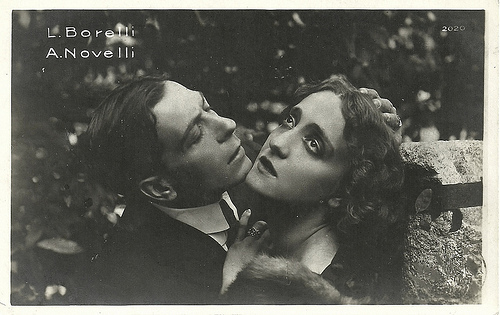
Italian postcard, no. 2020. Lyda Borelli and Amleto Novelli in Malombra (Carmine Gallone, 1917).
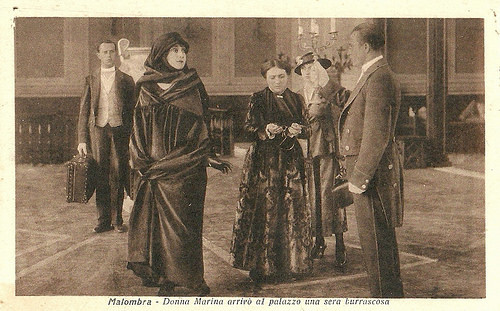
Italian postcard by IPA CT Duplex. Photo: Film Cines. Publicity still for Malombra (Carmine Gallone, 1917). Caption: Donna Marina ( Lyda Borelli ) arrived at the castle on a tempestuous night.

Italian postcard by IPA CT Duplex. Photo: Film Cines. Publicity still for Malombra (Carmine Gallone, 1917), starring Lyda Borelli. Caption: Count Cesare d'Ormengo (Augusto Mastripietri) and his secretary Mr. Steinegge (Amedeo Ciaffi) let donna Marina visit the castle and its neighbourhoods.

Franco-Italian postcard by IPA CT Duplex. Photo: Film Cines. Publicity still for Malombra (Carmine Gallone, 1917). Caption: Declaration [of love]. Left Edith Steinegge (Consuelo Spada) and right Corrado Silla ( Amleto Novelli ).
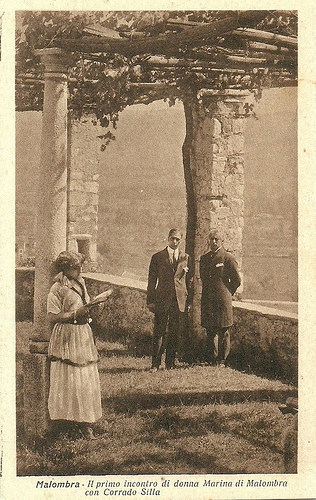
Italian postcard by IPA CT Duplex. Photo: Film Cines. Publicity still for Malombra (Carmine Gallone, 1917). Caption: The first encounter of donna Marina di Malombra with Corrado Silla.
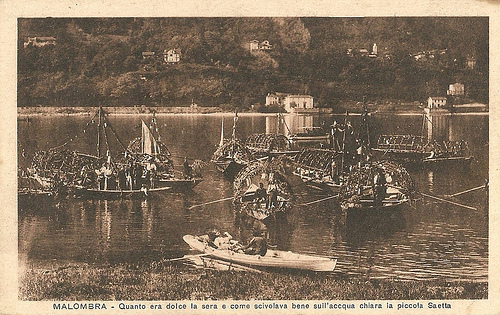
Italian postcard by IPA CT Duplex. Photo: Film Cines. Publicity still for Malombra (Carmine Gallone, 1917), with in the front Lyda Borelli . Caption: How sweet was the night and how well little Saetta slipped on the clear water.
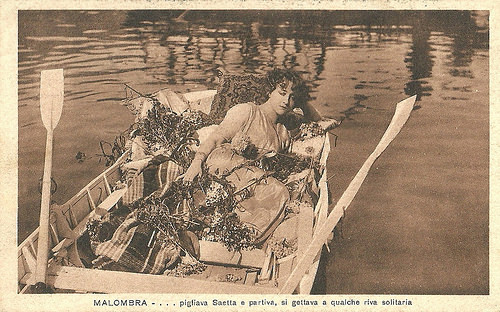
Italian postcard by IPA CT Duplex. Photo: Film Cines. Publicity still for Malombra (Carmine Gallone, 1917), starring Lyda Borelli . Caption: ...Saetta seized [the oars] and left, moving towards some solitary shore.

Italian postcard by IPA CT Duplex. Photo: Film Cines. Publicity still for Malombra (Carmine Gallone, 1917). Caption: He hurried to grab his hat, have a grand farewell gesture to Silla and open the door all at once.
Gothic melodrama
Lyda Borelli (1887-1959) was already an acclaimed stage actress before she became the first diva of the Italian silent cinema. One of her most important films is Malombra (1917), a gothic melodrama, set at Lake Como at the castle Malombra.
The young, orphaned countess Marina di Malombra (Borelli) comes to live with her uncle, Count d'Ormengo (Augusto Mastripietri). She chooses as her apartment the one overseeing the lake, though considered 'doomed' by the staff.
While at the castle, she meets the German secretary Steinegge (Amedeo Ciaffi), and the young writer Corrado Silla ( Amleto Novelli ). Silla is close with the count and Steinegge but he is also fond of the secretary's daughter, the bashful Edith (Consuelo Spada).
One night, during a Spring festival, Marina has drifted on the lake and is showered with flowers by the locals. When she comes back in her room, she finds by accident a secret drawer, discovering a glove, a lock of hair, a mirror an a diary. These objects belonged to her ancestor Cecilia, the first wife of her uncle's father.
Marina identifies herself with Cecilia, who died imprisoned after adultery. Marina thinks Cecilia has reincarnated in her, and she considers the count as the heir of his father's wrongdoings and therefore guilty. She startles the count with her accusations. Meanwhile Silla, author of the book A Dream, which Marina has been fascinated by, has written Marina letters addressed to 'Cecllia'.
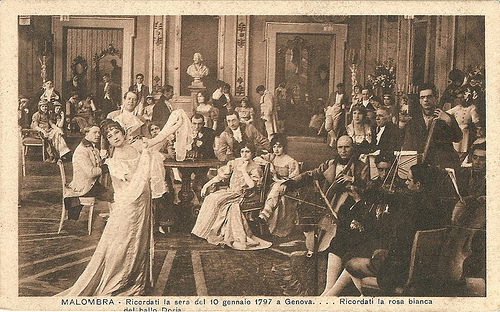
Italian postcard by IPA CT Duplex. Photo: Film Cines. Publicity still for Malombra (Carmine Gallone, 1917). Caption: Remember the night of 10 January 1797 in Genoa... Remember the white rose at the Doria ball.
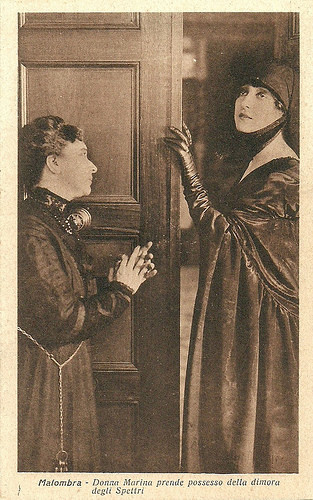
Italian postcard by IPA CT Duplex. Photo: Film Cines. Publicity still for Malombra (Carmine Gallone, 1917). Caption: Donna Marina took possession of the dwelling of the Ghosts.

Italian postcard by IPA CT Duplex. Photo: Film Cines. Publicity still for Malombra (Carmine Gallone, 1917). Caption: It looked as if Marina was the first wife his father, Countess Cecilia Varrega.
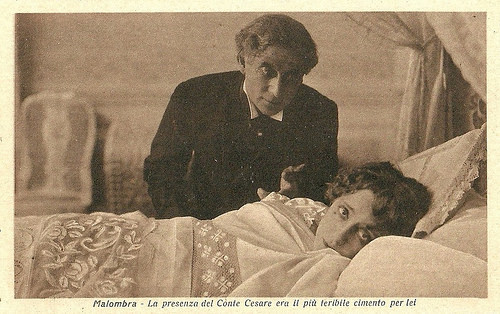
Italian postcard by IPA CT Duplex. Photo: Film Cines. Publicity still for Malombra (Carmine Gallone, 1917). Caption: The presence of count Cesare was the most terrible torture to her.
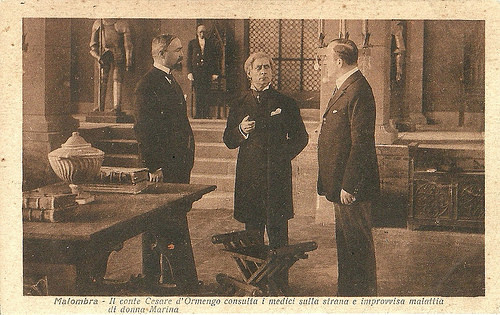
Italian postcard by IPA CT Duplex. Photo: Film Cines. Publicity still for Malombra (Carmine Gallone, 1917). Caption: Count Cesare d'Ormengo consulted the doctors on the strange and unexpected illness of donna Marina.
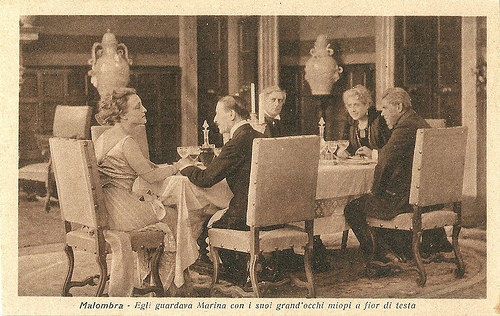
Italian postcard by IPA CT Duplex. Photo: Film Cines. Publicity still for Malombra (Carmine Gallone, 1917). Caption: He looked at Marina with his big myopic, bulging eyes.
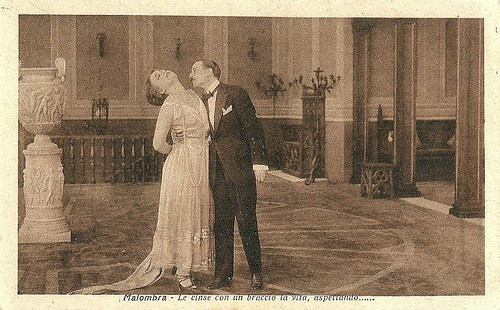
Italian postcard by IPA CT Duplex. Photo: Film Cines. Publicity still for Malombra (Carmine Gallone, 1917). Caption: He held her with one arm by the waist, hoping...
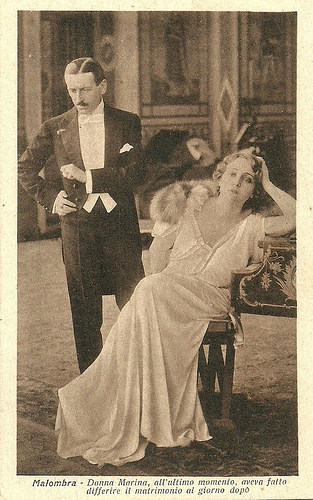
Italian postcard by IPA CT Duplex. Photo: Film Cines. Publicity still for Malombra (Carmine Gallone, 1917). Caption: At the last moment donna Marina had managed to postpone the marriage to the next day.
A hysterical fit
Her uncle tries to distract Marina by inviting friends and tries to match her with count Salvador (Francesco Cacace), a pale, cowardly aristocrat. Marina dislikes Salvador, which she repeatedly expresses during a dinner party and an excursion.
One night, while Marina's uncle has become mortally ill, Silla lands on the shore of the castle and is head over heels in love with Marina, who by now has lost her wits. He first plays along with her that she is Cecilia's reincarnation, just to make love to her.
When Marina discovers Silla only pretended she was Cecilia, she storms into the bedroom of the count, who is dying. In a hysterical fit, she shouts that she hates him. Silla carries her away. The count dies, too weak to have heard Marina's accusations.
The next day Marina calms down, so much that the doctors allow her a last caprice: a nightly dinner in the loggia of the castle, all adorned with flowers. A storm rises but the dinner proceeds. The doctors discover Marina hasn't recovered. Moreover, she kills Silla and flees with a boat on the stormy lake, towards a mortal vortex.
The Como Lake was also the site where the young Luchino Visconti passed his holidays. The 9-years-old Luchino had read the novel Malombra and had also seen the film version with Borelli. The romantic boy was fascinated by the story and by sunset, he always took his little boat to visit the shores of the lake.
The last scene of the novel is not visible in the surviving print of the film. In this silent version, the affair between Edith and Silla is not very prominent, in contrast to the book and the later 1941 sound version, directed by Mario Soldati and featuring Isa Miranda as Marina di Malombra.
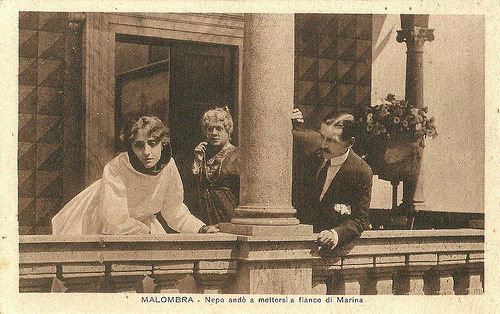
Italian postcard by IPA CT Duplex. Photo: Film Cines. Publicity still for Malombra (Carmine Gallone, 1917). Caption: Nepo (Francesco Cacace) went to place himself next to Marina.
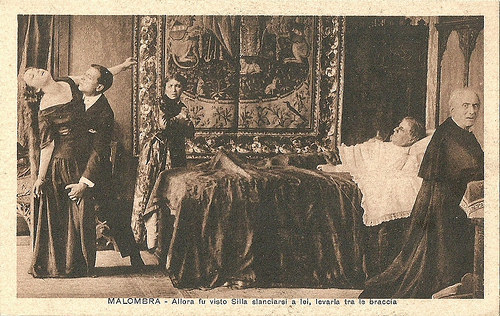
Italian postcard for Malombra (Carmine Gallone, 1917), starring Lyda Borelli and Amleto Novelli (both left) and Augusto Mastripietri (in bed). Caption: One noticed Silla throwing himself on her, lifting her with his arms.
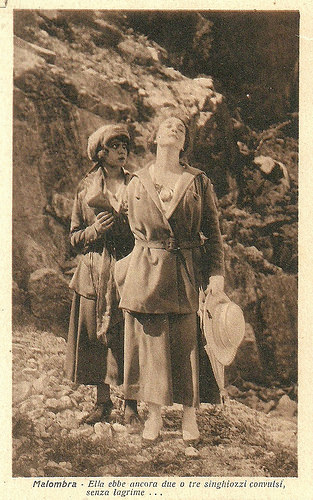
Italian postcard by IPA CT Duplex. Photo: Film Cines. Publicity still for Malombra (Carmine Gallone, 1917). Caption: She still had two or three convulsed sobs, without tears...
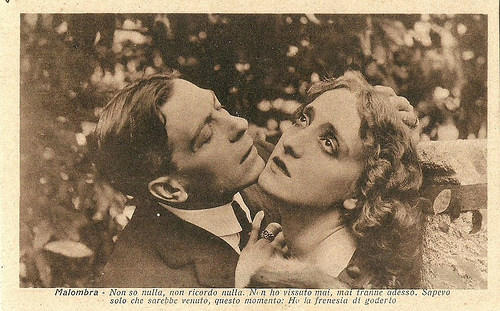
Italian postcard by IPA CT Duplex. Photo: Film Cines. Publicity still for Malombra (Carmine Gallone, 1917). Caption: I don't know nothing, I remember nothing. I never lived, never apart from now. I knew only you would come, this moment. I have the frenzy to enjoy it.

Italian postcard by IPA CT Duplex. Photo: Film Cines. Publicity still for Malombra (Carmine Gallone, 1917). Caption: For a moment he laid his hands on her arm. She shivered: her shoulders and her breasts lifted themselves.
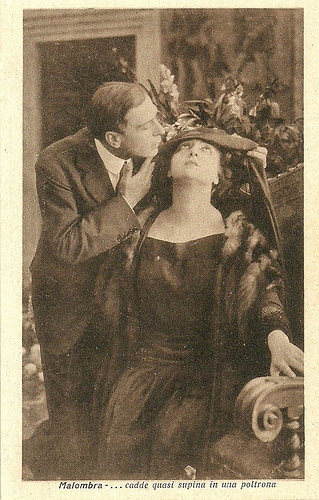
Italian postcard by IPA CT Duplex. Photo: Film Cines. Publicity still for Malombra (Carmine Gallone, 1917). Caption: ... she fell almost supine in an armchair.

Italian postcard by IPA CT Duplex. Photo: Film Cines. Publicity still for Malombra (Carmine Gallone, 1917). Caption: Here, she said, signing him to sit down on the ground next to her. All your memories...
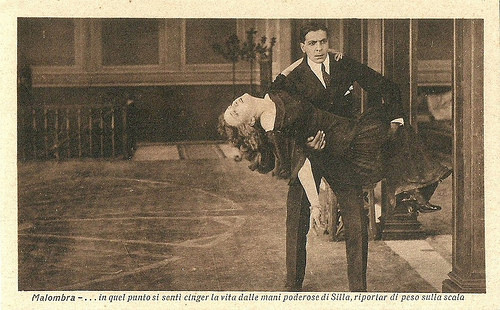
...at that moment she felt her waist held by the powerful hands of Silla, who lifted her back up the stairs.
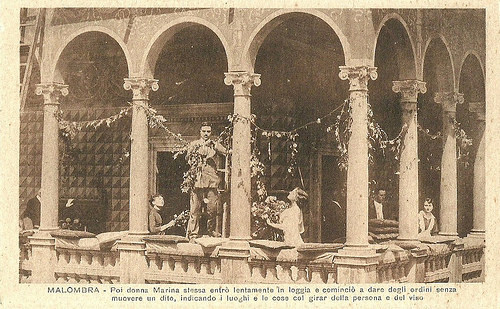
Italian postcard by IPA CT Duplex. Photo: Film Cines. Publicity still for Malombra (Carmine Gallone, 1917). Caption: Then donna Marina herself slowly entered the loggia and started to give orders without moving a finger, pointing at the places and things by the turning of her body and her face.
Sources: Laurence Schifano (Visconti, une vie exposée - French), Wikipedia and IMDb.

Italian postcard, no. 2020. Lyda Borelli and Amleto Novelli in Malombra (Carmine Gallone, 1917).

Italian postcard by IPA CT Duplex. Photo: Film Cines. Publicity still for Malombra (Carmine Gallone, 1917). Caption: Donna Marina ( Lyda Borelli ) arrived at the castle on a tempestuous night.

Italian postcard by IPA CT Duplex. Photo: Film Cines. Publicity still for Malombra (Carmine Gallone, 1917), starring Lyda Borelli. Caption: Count Cesare d'Ormengo (Augusto Mastripietri) and his secretary Mr. Steinegge (Amedeo Ciaffi) let donna Marina visit the castle and its neighbourhoods.

Franco-Italian postcard by IPA CT Duplex. Photo: Film Cines. Publicity still for Malombra (Carmine Gallone, 1917). Caption: Declaration [of love]. Left Edith Steinegge (Consuelo Spada) and right Corrado Silla ( Amleto Novelli ).

Italian postcard by IPA CT Duplex. Photo: Film Cines. Publicity still for Malombra (Carmine Gallone, 1917). Caption: The first encounter of donna Marina di Malombra with Corrado Silla.

Italian postcard by IPA CT Duplex. Photo: Film Cines. Publicity still for Malombra (Carmine Gallone, 1917), with in the front Lyda Borelli . Caption: How sweet was the night and how well little Saetta slipped on the clear water.

Italian postcard by IPA CT Duplex. Photo: Film Cines. Publicity still for Malombra (Carmine Gallone, 1917), starring Lyda Borelli . Caption: ...Saetta seized [the oars] and left, moving towards some solitary shore.

Italian postcard by IPA CT Duplex. Photo: Film Cines. Publicity still for Malombra (Carmine Gallone, 1917). Caption: He hurried to grab his hat, have a grand farewell gesture to Silla and open the door all at once.
Gothic melodrama
Lyda Borelli (1887-1959) was already an acclaimed stage actress before she became the first diva of the Italian silent cinema. One of her most important films is Malombra (1917), a gothic melodrama, set at Lake Como at the castle Malombra.
The young, orphaned countess Marina di Malombra (Borelli) comes to live with her uncle, Count d'Ormengo (Augusto Mastripietri). She chooses as her apartment the one overseeing the lake, though considered 'doomed' by the staff.
While at the castle, she meets the German secretary Steinegge (Amedeo Ciaffi), and the young writer Corrado Silla ( Amleto Novelli ). Silla is close with the count and Steinegge but he is also fond of the secretary's daughter, the bashful Edith (Consuelo Spada).
One night, during a Spring festival, Marina has drifted on the lake and is showered with flowers by the locals. When she comes back in her room, she finds by accident a secret drawer, discovering a glove, a lock of hair, a mirror an a diary. These objects belonged to her ancestor Cecilia, the first wife of her uncle's father.
Marina identifies herself with Cecilia, who died imprisoned after adultery. Marina thinks Cecilia has reincarnated in her, and she considers the count as the heir of his father's wrongdoings and therefore guilty. She startles the count with her accusations. Meanwhile Silla, author of the book A Dream, which Marina has been fascinated by, has written Marina letters addressed to 'Cecllia'.

Italian postcard by IPA CT Duplex. Photo: Film Cines. Publicity still for Malombra (Carmine Gallone, 1917). Caption: Remember the night of 10 January 1797 in Genoa... Remember the white rose at the Doria ball.

Italian postcard by IPA CT Duplex. Photo: Film Cines. Publicity still for Malombra (Carmine Gallone, 1917). Caption: Donna Marina took possession of the dwelling of the Ghosts.

Italian postcard by IPA CT Duplex. Photo: Film Cines. Publicity still for Malombra (Carmine Gallone, 1917). Caption: It looked as if Marina was the first wife his father, Countess Cecilia Varrega.

Italian postcard by IPA CT Duplex. Photo: Film Cines. Publicity still for Malombra (Carmine Gallone, 1917). Caption: The presence of count Cesare was the most terrible torture to her.

Italian postcard by IPA CT Duplex. Photo: Film Cines. Publicity still for Malombra (Carmine Gallone, 1917). Caption: Count Cesare d'Ormengo consulted the doctors on the strange and unexpected illness of donna Marina.

Italian postcard by IPA CT Duplex. Photo: Film Cines. Publicity still for Malombra (Carmine Gallone, 1917). Caption: He looked at Marina with his big myopic, bulging eyes.

Italian postcard by IPA CT Duplex. Photo: Film Cines. Publicity still for Malombra (Carmine Gallone, 1917). Caption: He held her with one arm by the waist, hoping...

Italian postcard by IPA CT Duplex. Photo: Film Cines. Publicity still for Malombra (Carmine Gallone, 1917). Caption: At the last moment donna Marina had managed to postpone the marriage to the next day.
A hysterical fit
Her uncle tries to distract Marina by inviting friends and tries to match her with count Salvador (Francesco Cacace), a pale, cowardly aristocrat. Marina dislikes Salvador, which she repeatedly expresses during a dinner party and an excursion.
One night, while Marina's uncle has become mortally ill, Silla lands on the shore of the castle and is head over heels in love with Marina, who by now has lost her wits. He first plays along with her that she is Cecilia's reincarnation, just to make love to her.
When Marina discovers Silla only pretended she was Cecilia, she storms into the bedroom of the count, who is dying. In a hysterical fit, she shouts that she hates him. Silla carries her away. The count dies, too weak to have heard Marina's accusations.
The next day Marina calms down, so much that the doctors allow her a last caprice: a nightly dinner in the loggia of the castle, all adorned with flowers. A storm rises but the dinner proceeds. The doctors discover Marina hasn't recovered. Moreover, she kills Silla and flees with a boat on the stormy lake, towards a mortal vortex.
The Como Lake was also the site where the young Luchino Visconti passed his holidays. The 9-years-old Luchino had read the novel Malombra and had also seen the film version with Borelli. The romantic boy was fascinated by the story and by sunset, he always took his little boat to visit the shores of the lake.
The last scene of the novel is not visible in the surviving print of the film. In this silent version, the affair between Edith and Silla is not very prominent, in contrast to the book and the later 1941 sound version, directed by Mario Soldati and featuring Isa Miranda as Marina di Malombra.

Italian postcard by IPA CT Duplex. Photo: Film Cines. Publicity still for Malombra (Carmine Gallone, 1917). Caption: Nepo (Francesco Cacace) went to place himself next to Marina.

Italian postcard for Malombra (Carmine Gallone, 1917), starring Lyda Borelli and Amleto Novelli (both left) and Augusto Mastripietri (in bed). Caption: One noticed Silla throwing himself on her, lifting her with his arms.

Italian postcard by IPA CT Duplex. Photo: Film Cines. Publicity still for Malombra (Carmine Gallone, 1917). Caption: She still had two or three convulsed sobs, without tears...

Italian postcard by IPA CT Duplex. Photo: Film Cines. Publicity still for Malombra (Carmine Gallone, 1917). Caption: I don't know nothing, I remember nothing. I never lived, never apart from now. I knew only you would come, this moment. I have the frenzy to enjoy it.

Italian postcard by IPA CT Duplex. Photo: Film Cines. Publicity still for Malombra (Carmine Gallone, 1917). Caption: For a moment he laid his hands on her arm. She shivered: her shoulders and her breasts lifted themselves.

Italian postcard by IPA CT Duplex. Photo: Film Cines. Publicity still for Malombra (Carmine Gallone, 1917). Caption: ... she fell almost supine in an armchair.

Italian postcard by IPA CT Duplex. Photo: Film Cines. Publicity still for Malombra (Carmine Gallone, 1917). Caption: Here, she said, signing him to sit down on the ground next to her. All your memories...

...at that moment she felt her waist held by the powerful hands of Silla, who lifted her back up the stairs.

Italian postcard by IPA CT Duplex. Photo: Film Cines. Publicity still for Malombra (Carmine Gallone, 1917). Caption: Then donna Marina herself slowly entered the loggia and started to give orders without moving a finger, pointing at the places and things by the turning of her body and her face.
Sources: Laurence Schifano (Visconti, une vie exposée - French), Wikipedia and IMDb.
Published on October 04, 2016 22:00
October 3, 2016
Marianna Vertinskaya
Beautiful Marianna Vertinskaya (1943) is a Russian stage actress, who starred in several good Soviet films of the 1960s and 1970s. She is the sister of film star Anastasiya Vertinskaya.
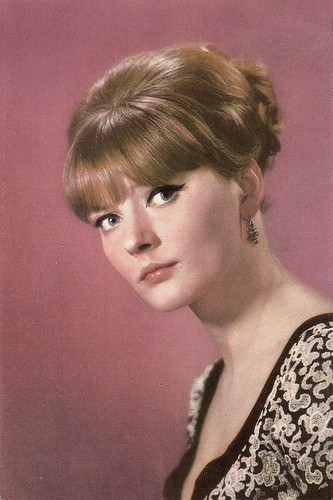
Russian postcard, no. 71-2185. This postcard was printed in an edition of 200.000 cards.
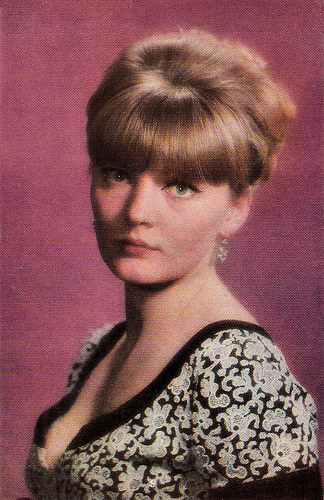
Russian postcard, no. A 06184, 1968. This postcard was printed in an edition of 300.000 cards.
Emotional trauma
Marianna Aleksandrovna Vertinskaya was in 1943, on a train going to Shanghai, China, which was home to a large Russian colony at the time. Her father, Aleksandr Vertinskiy was a legendary White Russian émigré, who was a popular actor, singer and songwriter. Her mother, Lidiya Vertinskaya (née Lidia Vladimirovna Tsirgvava), was also a Russian emigre who was born into a Georgian-Russian family in Kharbin.
Her mother gave her the in Russia unusual name Marianna after the beloved of Robin Hood. Lidiya simply loved the American film The Adventures of Robin Hood (Michael Curtiz, 1938), with Errol Flynn as the legendary robber.
In order to support his family in Shanghai, Aleksandr Vertinskiy had to give two concerts a day during the first years. They decided to return to Moscow, where a second daughter, Anastasiya Vertinskaya , was born in 1944. Marianna and Anastasiya had a happy childhood in Russia. They were brought up in a multi-lingual family where they enjoyed an intellectually stimulating environment, and a highly cultural atmosphere of their parents circle.
Marianna was fond of her father, who invested much of his talent and energy in his daughter's education. Her famous father died when Marianna was 15, and she suffered from an emotional trauma. From 1962 till 1966 she studied acting under Aleksandr Borisov at the Shchukin Theatre School in Moscow.
Since 1966 she has been a member of the Vakhtangov Theatre in Moscow. Marianna Vertinskaya shone in the title role in the legendary 1963 re-creation of Vakhtangov's production of Carlo Gozzi's comedy Princess Turandot. She also made memorable appearances in Fyodor Dostoyevsky's Idiot (The Idiot), in Moliere's Meshchanin vo dvoryansyve (Le Bourgeois Gentilhomme), and in other plays at the Vakhtangov Theatre.
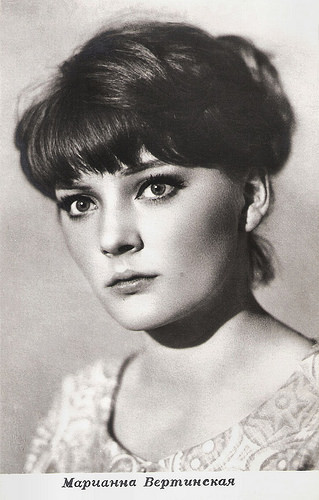
Russian postcard, no. A 03053, 1967. This postcard was printed in an edition of 50.000 cards.
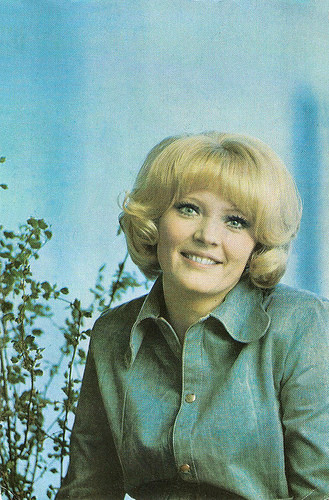
Russian postcard, no. A 309. This postcard was printed in an edition of 300.000 cards.
The Russian answer to the Nouvelle Vague
Marianna Vertinskaya made her film debut with a small part in the crime drama Visokosnyy god/ Leap Year (Anatoli Efros, 1962). She played a supporting part in the coming of age drama Mne dvadtsat let/I Am Twenty (Marlen Khutsiev, 1965). The film is now seen as the Russian answer to the Nouvelle Vague in France.
At the time, the film invoked Soviet premier Nikita Khruschev's sharp criticism. At the censor's insistence the film was re-cut. Mne dvadtsat let follows Sergei (Valentin Popov), his two best friends, Nikolai and Slava, and his eventual love interest, Anya (Vertinskaya), and juxtaposes their aspirations against the harsh realities of everyday life in the Soviet Union in 1960.
The following year, Marianna played the female leads in two films. She starred opposite Nikita Mikhalkov and Oleg Strizhenov in the drama Pereklichka/Roll-Call (Daniil Khrabrovitsky, 1966). The second film was the family adventure Gorod masterov/The City of Masters (Vladimir Bychkov, 1966).
Elaine Freeland at IMDb : “Although far removed from Tamara Gabbe's original theater play of the same name, Gorod Masterov is an excellent work in its own right. A good example of the so-called po motivam Soviet adaptation policy which allowed filmmakers unlimited freedom when it came to changing the plot, characters and even the idea of the original story, Gorod Masterov used that freedom only to emphasize the main points of Gabbe's tale. That turned a meticulously researched, beautifully worded historical play inspired by the events of the famous Marseille rebellion into a never-never-landish children's fantasy movie.”
Vertinskaya also co-starred with Oleg Strizhenov in the Sci-Fi comedy Ego zvali Robert/We Called Him Robert (Ilya Olshvanger, 1967), and was one of the brides in the comedy Sem nevest efreytora Zbrueva/The Seven Brides of Lance-Corporal Zbruyev (Vitaliy Melnikov, 1971). She had the leading role in Nave zem buras/Nave under sail (Ada Neretniece, 1976).
Her later films include Dialog s prodolzheniyem/A continued dialogue (Gennadi Karyuk, Aleksandr Lapshin, 1980), Zhenshchina v more/The Woman in the Sea (Vyacheslav Krishtofovich, 1992) and her most recent film, Vlyublyonnye 2/Lovers 2 (Elyer Ishmukhamedov, 2004).
Vertinskaya was designated Honourable Actress of Russia. She has been married three times: to architect Ilya Bylinkin (1967-1973), to actor Boris Khmelnitskiy (1976-1980) and to businessman Zoran Kazimirovic (1983-1996). She has two daughters: presenter Aleksandra Bylinkina (1970) with Ilya Bylinkin, and designer Darya Khmelnitskaya (1978) with Boris Khmelnitskiy. Marianna Vertinskaya lives and works in Moscow, Russia.
Trailer for Ego zvali Robert/We Called Him Robert (1967). Source: Slava Batareykin (YouTube).
Sources: (IMDb), Elaine Freeland (IMDb), ivi.ru (Russian), AllMovie and .

Russian postcard, no. 71-2185. This postcard was printed in an edition of 200.000 cards.

Russian postcard, no. A 06184, 1968. This postcard was printed in an edition of 300.000 cards.
Emotional trauma
Marianna Aleksandrovna Vertinskaya was in 1943, on a train going to Shanghai, China, which was home to a large Russian colony at the time. Her father, Aleksandr Vertinskiy was a legendary White Russian émigré, who was a popular actor, singer and songwriter. Her mother, Lidiya Vertinskaya (née Lidia Vladimirovna Tsirgvava), was also a Russian emigre who was born into a Georgian-Russian family in Kharbin.
Her mother gave her the in Russia unusual name Marianna after the beloved of Robin Hood. Lidiya simply loved the American film The Adventures of Robin Hood (Michael Curtiz, 1938), with Errol Flynn as the legendary robber.
In order to support his family in Shanghai, Aleksandr Vertinskiy had to give two concerts a day during the first years. They decided to return to Moscow, where a second daughter, Anastasiya Vertinskaya , was born in 1944. Marianna and Anastasiya had a happy childhood in Russia. They were brought up in a multi-lingual family where they enjoyed an intellectually stimulating environment, and a highly cultural atmosphere of their parents circle.
Marianna was fond of her father, who invested much of his talent and energy in his daughter's education. Her famous father died when Marianna was 15, and she suffered from an emotional trauma. From 1962 till 1966 she studied acting under Aleksandr Borisov at the Shchukin Theatre School in Moscow.
Since 1966 she has been a member of the Vakhtangov Theatre in Moscow. Marianna Vertinskaya shone in the title role in the legendary 1963 re-creation of Vakhtangov's production of Carlo Gozzi's comedy Princess Turandot. She also made memorable appearances in Fyodor Dostoyevsky's Idiot (The Idiot), in Moliere's Meshchanin vo dvoryansyve (Le Bourgeois Gentilhomme), and in other plays at the Vakhtangov Theatre.

Russian postcard, no. A 03053, 1967. This postcard was printed in an edition of 50.000 cards.

Russian postcard, no. A 309. This postcard was printed in an edition of 300.000 cards.
The Russian answer to the Nouvelle Vague
Marianna Vertinskaya made her film debut with a small part in the crime drama Visokosnyy god/ Leap Year (Anatoli Efros, 1962). She played a supporting part in the coming of age drama Mne dvadtsat let/I Am Twenty (Marlen Khutsiev, 1965). The film is now seen as the Russian answer to the Nouvelle Vague in France.
At the time, the film invoked Soviet premier Nikita Khruschev's sharp criticism. At the censor's insistence the film was re-cut. Mne dvadtsat let follows Sergei (Valentin Popov), his two best friends, Nikolai and Slava, and his eventual love interest, Anya (Vertinskaya), and juxtaposes their aspirations against the harsh realities of everyday life in the Soviet Union in 1960.
The following year, Marianna played the female leads in two films. She starred opposite Nikita Mikhalkov and Oleg Strizhenov in the drama Pereklichka/Roll-Call (Daniil Khrabrovitsky, 1966). The second film was the family adventure Gorod masterov/The City of Masters (Vladimir Bychkov, 1966).
Elaine Freeland at IMDb : “Although far removed from Tamara Gabbe's original theater play of the same name, Gorod Masterov is an excellent work in its own right. A good example of the so-called po motivam Soviet adaptation policy which allowed filmmakers unlimited freedom when it came to changing the plot, characters and even the idea of the original story, Gorod Masterov used that freedom only to emphasize the main points of Gabbe's tale. That turned a meticulously researched, beautifully worded historical play inspired by the events of the famous Marseille rebellion into a never-never-landish children's fantasy movie.”
Vertinskaya also co-starred with Oleg Strizhenov in the Sci-Fi comedy Ego zvali Robert/We Called Him Robert (Ilya Olshvanger, 1967), and was one of the brides in the comedy Sem nevest efreytora Zbrueva/The Seven Brides of Lance-Corporal Zbruyev (Vitaliy Melnikov, 1971). She had the leading role in Nave zem buras/Nave under sail (Ada Neretniece, 1976).
Her later films include Dialog s prodolzheniyem/A continued dialogue (Gennadi Karyuk, Aleksandr Lapshin, 1980), Zhenshchina v more/The Woman in the Sea (Vyacheslav Krishtofovich, 1992) and her most recent film, Vlyublyonnye 2/Lovers 2 (Elyer Ishmukhamedov, 2004).
Vertinskaya was designated Honourable Actress of Russia. She has been married three times: to architect Ilya Bylinkin (1967-1973), to actor Boris Khmelnitskiy (1976-1980) and to businessman Zoran Kazimirovic (1983-1996). She has two daughters: presenter Aleksandra Bylinkina (1970) with Ilya Bylinkin, and designer Darya Khmelnitskaya (1978) with Boris Khmelnitskiy. Marianna Vertinskaya lives and works in Moscow, Russia.
Trailer for Ego zvali Robert/We Called Him Robert (1967). Source: Slava Batareykin (YouTube).
Sources: (IMDb), Elaine Freeland (IMDb), ivi.ru (Russian), AllMovie and .
Published on October 03, 2016 22:00
October 2, 2016
Susanne Cramer
Beautiful German actress Susanne Cramer (1936-1969) was known for her film career in German, French and American films, but also for her tumultuous private life.
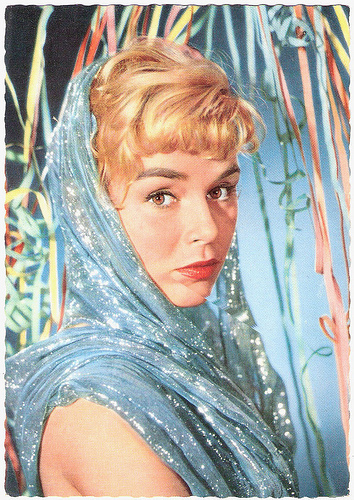
German postcard by Ufa (Universum-Film Aktiengesellschaft) Berlin-Tempelhof, no. CK-114. Retail price: 30 Pfg. Photo: Arthur Grimm.
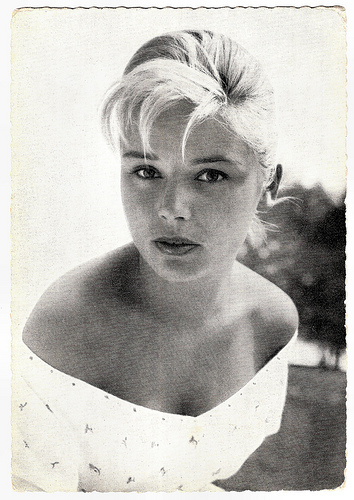
German postcard by Filmbilder-Vertrieb Ernst Freihoff, Essen, no. 109. Retail price: 10 Pfg. Photo: Joe Niczky.
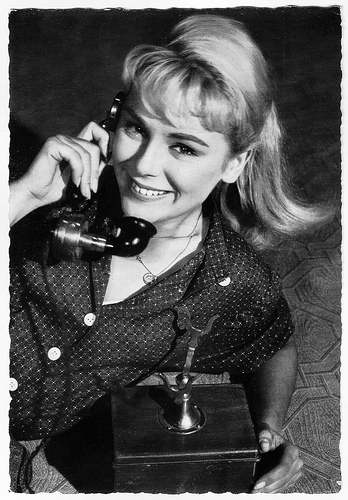
German postcard by WS-Druck, Wanne-Eickel, no. 229. Photo: Bavaria / Schorcht / Ringpress / Vogelmann.
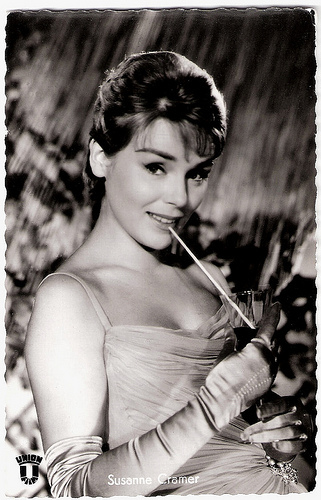
German postcard by Kolibri-Verlag, Minden/Westf., no. 467. Photo: Zeyn / Union / Arrthur Grimm. Publicity still for Der lachende Vagabund/The Laughing Vagabond (Thomas Engel, 1958).
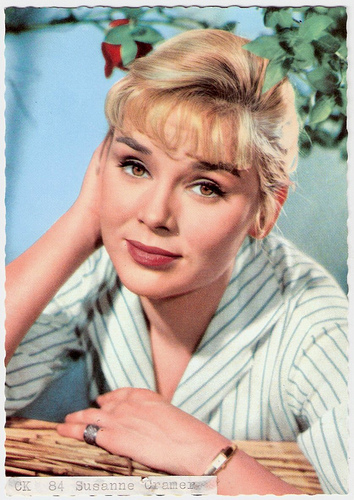
German postcard by Ufa (Universum-Film Aktiengesellschaft) Berlin-Tempelhof, no. CK-84. Retail price: 30 Pfg. Photo: Ufa.
Suicide Efforts
Susanne Cramer, also known as Susan Cramer and Suzanne Cramer, was born in Frankfurt am Main, Germany in 1936. At 20 she married actor Hermann Nehlsen, who was 17 years her senior. He stimulated her film ambitions.
She started her career with two supporting roles in Waldwinter/Winter in the Woods (Wolfgang Liebeneiner, 1956) with Claus Holm and the Heimatfilm Rot ist die Liebe/Love is Red (Karl Hartl, 1956) starring Cornell Borchers before she played the leading lady opposite Heinz Erhardt in the comedy Die gestohlene Hose/The Stolen Trousers (Géza von Cziffra, 1956), and opposite Claus Biederstaedt in another comedy, Kleines Zelt und große Liebe/Two in a Sleeping Bag (Rainer Geis, 1956).
That year she also appeared in the French drama Les assassins du dimanche/Every Second Counts (Alex Joffé, 1956). Her marriage quickly went sour, and she had an affair with Claus Biederstaedt which ended in two suicide efforts.
In 1957 she played in seven films, including Wie ein Sturmwind/The Night of the Storm (Falk Harnack, 1957) with Lilli Palmer and Ivan Desny , the comedy Witwer mit 5 Töchtern/Widower with 5 Daughters (Erich Engels, 1957) again opposite Heinz Erhardt, and Vacanze a Ischia/ Holiday Island (Mario Camerini, 1957) with Vittorio de Sica .
In 1958 Susanne married colleague actor Helmuth Lohner, but a divorce followed already after only five months. They married a second time and a daughter was born, Konstanze Lohner, but after a short time a second divorce followed.
Other films in which she appeared were the crime film Der Greifer/The Copper (Eugen York, 1958) with Hans Albers , Nick Knattertons Abenteuer - Der Raub der Gloria Nylon/The Kidnapping of Miss Nylon (Hans Quest, 1959), and another comedy with Heinz Erhardt, Drei Mann in einem Boot/Three men in a Boat (Helmut Weiss, 1961).

German postcard by Ufa, Berlin-Tempelhof, no. FK-3573. Photo: Eberhard Schmidt / Ufa.
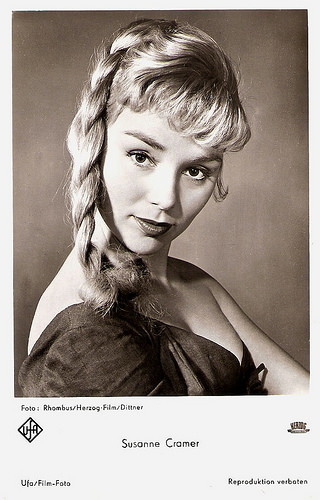
German postcard by Ufa, Berlin-Tempelhof, no. FK-3714. Photo: Rhombus / Herzog-Film / Dittner.
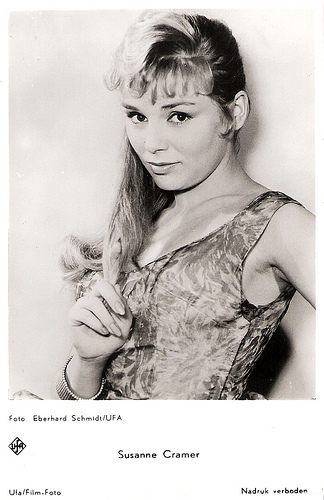
Dutch postcard by Gebr. Spanjersberg N.V., Rotterdam, no. 3570/958. Photo: Eberhard Schmidt / UFA (Universum-Film Aktiengesellschaft, Berlin-Tempelhof).
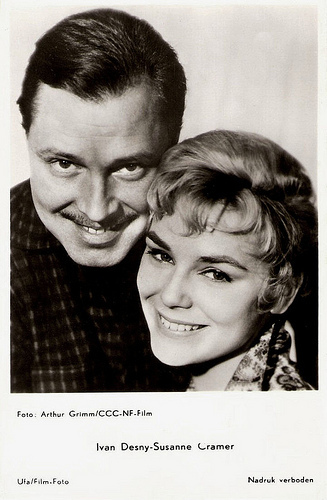
Dutch postcard by Gebr. Spanjersberg N.V., Rotterdam, no. 3305. Photo: Arthur Grimm / CCC-NF-Film. Publicity still for Wie ein Sturmwind/Tempestuous Love (Falk Harnack, 1957) with Ivan Desny. Spanjersberg was the Dutch licency holder for Ufa/Film-Foto (Universum-Film Aktiengesellschaft, Berlin-Tempelhof).

Dutch postcard by Gebr. Spanjersberg N.V., Rotterdam, no. 3712. Photo: Rhombus / Herzog-Film / Dittner / Ufa.
Shocking Experience
Susanne Cramer moved to Hollywood and there she appeared in episodes of several popular TV-series like Perry Mason (1964-1965), Get Smart (1965), Bonanza (1965), Hogan's Heroes (1966) and Ironside (1967).
She also played small parts in films like the comedy Bedtime Story (Ralph Levy, 1964) starring Marlon Brando and David Niven , and Dear Brigitte (Henry Koster, 1965) starring James Stewart. She married the American actor Kevin Hagen, and they stayed together for the rest of her life.
In 1966, when she wanted to visit her colleague Renate Ewert in München (Munich), she found her friend dead. According to some sources Renate was already dead for six days; other sources say even for three weeks. This shocking experience bothered Susanne deeply.
There were also rumours about her own death in 1969 by pneumonia in a private clinic in Hollywood. A medical malpractice reportedly would have really caused her death. Susanne Cramer was only 32 years old.
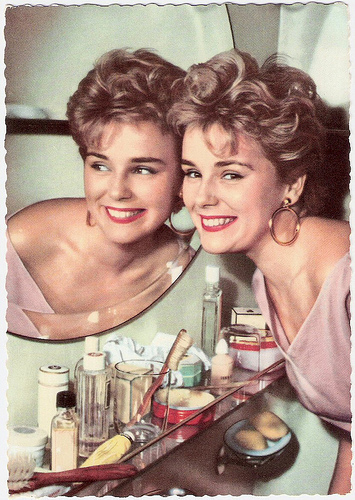
German postcard by Ufa (Universum-Film Aktiengesellschaft) Berlin-Tempelhof, no. CK-63. Retail price: 30 Pfg. Photo: Gérard Décaux / Ufa.
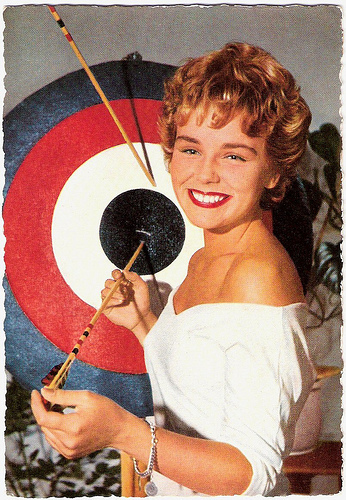
German postcard by WS-Druck, Wanne-Eickel, no. F 77. Photo: Klaus Collignon.
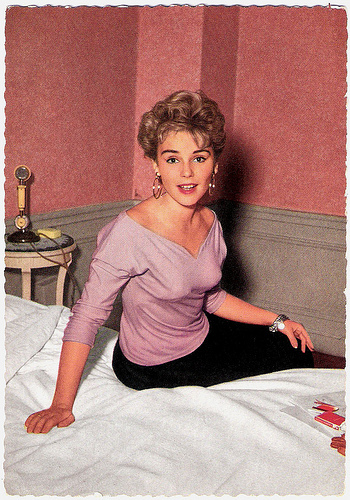
German postcard by Ufa (Universum-Film Aktiengesellschaft) Berlin-Tempelhof, no. CK-59. Retail price: 30 Pfg. Photo: Gérard Décaux / Ufa.
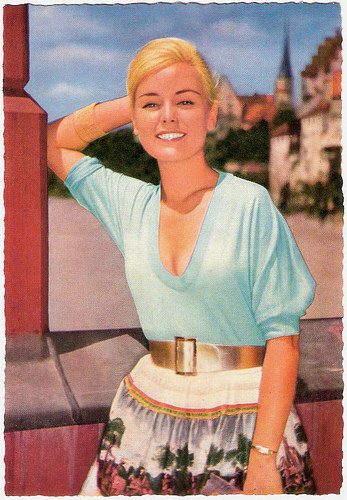
German postcard by WS-Druck, Wanne-Eickel, no. F-30. Photo: Ringpress / Vogelmann / Bavaria.
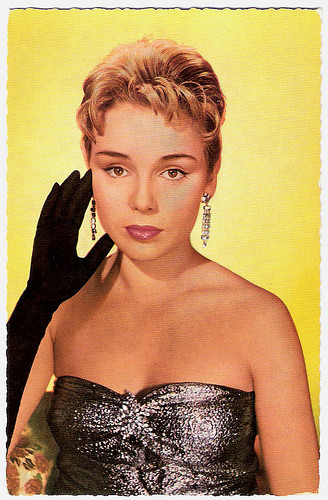
German postcard by Kunst und Bild, Berlin-Charlottenburg, no. C D 15.
Sources: Peter Hoffmann (Biografie.de), Wikipedia (German), and .

German postcard by Ufa (Universum-Film Aktiengesellschaft) Berlin-Tempelhof, no. CK-114. Retail price: 30 Pfg. Photo: Arthur Grimm.

German postcard by Filmbilder-Vertrieb Ernst Freihoff, Essen, no. 109. Retail price: 10 Pfg. Photo: Joe Niczky.

German postcard by WS-Druck, Wanne-Eickel, no. 229. Photo: Bavaria / Schorcht / Ringpress / Vogelmann.

German postcard by Kolibri-Verlag, Minden/Westf., no. 467. Photo: Zeyn / Union / Arrthur Grimm. Publicity still for Der lachende Vagabund/The Laughing Vagabond (Thomas Engel, 1958).

German postcard by Ufa (Universum-Film Aktiengesellschaft) Berlin-Tempelhof, no. CK-84. Retail price: 30 Pfg. Photo: Ufa.
Suicide Efforts
Susanne Cramer, also known as Susan Cramer and Suzanne Cramer, was born in Frankfurt am Main, Germany in 1936. At 20 she married actor Hermann Nehlsen, who was 17 years her senior. He stimulated her film ambitions.
She started her career with two supporting roles in Waldwinter/Winter in the Woods (Wolfgang Liebeneiner, 1956) with Claus Holm and the Heimatfilm Rot ist die Liebe/Love is Red (Karl Hartl, 1956) starring Cornell Borchers before she played the leading lady opposite Heinz Erhardt in the comedy Die gestohlene Hose/The Stolen Trousers (Géza von Cziffra, 1956), and opposite Claus Biederstaedt in another comedy, Kleines Zelt und große Liebe/Two in a Sleeping Bag (Rainer Geis, 1956).
That year she also appeared in the French drama Les assassins du dimanche/Every Second Counts (Alex Joffé, 1956). Her marriage quickly went sour, and she had an affair with Claus Biederstaedt which ended in two suicide efforts.
In 1957 she played in seven films, including Wie ein Sturmwind/The Night of the Storm (Falk Harnack, 1957) with Lilli Palmer and Ivan Desny , the comedy Witwer mit 5 Töchtern/Widower with 5 Daughters (Erich Engels, 1957) again opposite Heinz Erhardt, and Vacanze a Ischia/ Holiday Island (Mario Camerini, 1957) with Vittorio de Sica .
In 1958 Susanne married colleague actor Helmuth Lohner, but a divorce followed already after only five months. They married a second time and a daughter was born, Konstanze Lohner, but after a short time a second divorce followed.
Other films in which she appeared were the crime film Der Greifer/The Copper (Eugen York, 1958) with Hans Albers , Nick Knattertons Abenteuer - Der Raub der Gloria Nylon/The Kidnapping of Miss Nylon (Hans Quest, 1959), and another comedy with Heinz Erhardt, Drei Mann in einem Boot/Three men in a Boat (Helmut Weiss, 1961).

German postcard by Ufa, Berlin-Tempelhof, no. FK-3573. Photo: Eberhard Schmidt / Ufa.

German postcard by Ufa, Berlin-Tempelhof, no. FK-3714. Photo: Rhombus / Herzog-Film / Dittner.

Dutch postcard by Gebr. Spanjersberg N.V., Rotterdam, no. 3570/958. Photo: Eberhard Schmidt / UFA (Universum-Film Aktiengesellschaft, Berlin-Tempelhof).

Dutch postcard by Gebr. Spanjersberg N.V., Rotterdam, no. 3305. Photo: Arthur Grimm / CCC-NF-Film. Publicity still for Wie ein Sturmwind/Tempestuous Love (Falk Harnack, 1957) with Ivan Desny. Spanjersberg was the Dutch licency holder for Ufa/Film-Foto (Universum-Film Aktiengesellschaft, Berlin-Tempelhof).

Dutch postcard by Gebr. Spanjersberg N.V., Rotterdam, no. 3712. Photo: Rhombus / Herzog-Film / Dittner / Ufa.
Shocking Experience
Susanne Cramer moved to Hollywood and there she appeared in episodes of several popular TV-series like Perry Mason (1964-1965), Get Smart (1965), Bonanza (1965), Hogan's Heroes (1966) and Ironside (1967).
She also played small parts in films like the comedy Bedtime Story (Ralph Levy, 1964) starring Marlon Brando and David Niven , and Dear Brigitte (Henry Koster, 1965) starring James Stewart. She married the American actor Kevin Hagen, and they stayed together for the rest of her life.
In 1966, when she wanted to visit her colleague Renate Ewert in München (Munich), she found her friend dead. According to some sources Renate was already dead for six days; other sources say even for three weeks. This shocking experience bothered Susanne deeply.
There were also rumours about her own death in 1969 by pneumonia in a private clinic in Hollywood. A medical malpractice reportedly would have really caused her death. Susanne Cramer was only 32 years old.

German postcard by Ufa (Universum-Film Aktiengesellschaft) Berlin-Tempelhof, no. CK-63. Retail price: 30 Pfg. Photo: Gérard Décaux / Ufa.

German postcard by WS-Druck, Wanne-Eickel, no. F 77. Photo: Klaus Collignon.

German postcard by Ufa (Universum-Film Aktiengesellschaft) Berlin-Tempelhof, no. CK-59. Retail price: 30 Pfg. Photo: Gérard Décaux / Ufa.

German postcard by WS-Druck, Wanne-Eickel, no. F-30. Photo: Ringpress / Vogelmann / Bavaria.

German postcard by Kunst und Bild, Berlin-Charlottenburg, no. C D 15.
Sources: Peter Hoffmann (Biografie.de), Wikipedia (German), and .
Published on October 02, 2016 22:00
October 1, 2016
The Polish silent cinema
The 35th Pordenone Silent Film Festival, Le Giornate del Cinema Muto (1-8 October 2016) opens tonight with the screening of The Mysterious Lady (Fred Niblo, 1928) starring Greta Garbo. The silent film festival offers again rediscoveries of lost films and several interesting programmes. The new festival director Jay Weissberg compiled a programme on the Polish silent cinema which demonstrates the cosmopolitan nature of the Polish film industry of the time, and highlights some of their great filmmakers. In a salute to Pordenone which we sadly can't visit this year, EFSP presents 12 great and cosmopolitan Polish silent film stars.
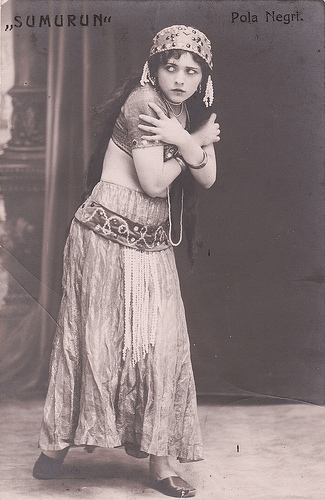
Polish postcard. Photo: publicity still for the play Sumurun. Collection: Marlene Pilaete.
Polish film actress Pola Negri (1894-1987) achieved notoriety as a femme fatale in silent films between 1910s and 1930s.
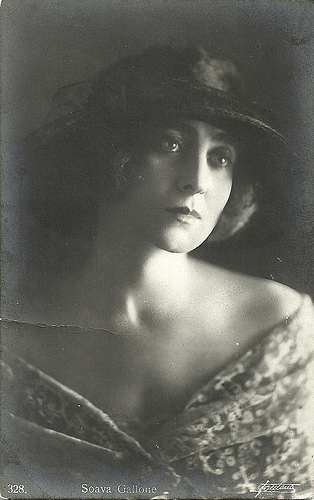
Italian postcard by Ed. A. Traldi, Milano, no. 328. Photo: Fontana.
Polish actress Soava Gallone (1880-1957) was one of the divas of the Italian silent cinema.
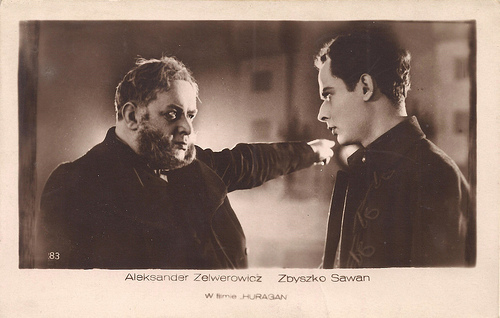
Polish postcard, no. 83. Photo: publicity still for Huragan/Hurricane (Joseph Lejtes, 1928) with Zbyszko Sawan and Aleksander Zelwerowicz. Collection: Joanna.
Aleksander Zelwerowicz (1877-1955) was a Polish actor, director, theatre president and a teacher. He received the Order of Polonia Restituta, one of Poland's highest Orders. He is also one of the Polish Righteous among the Nations, recognised by Yad Vashem as non-Jews who saved Jews from extermination during the Holocaust.
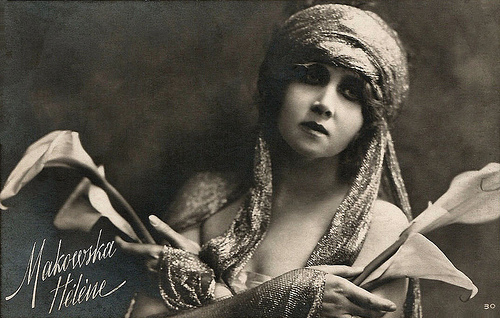
Italian postcard, no. 30. Collection: Didier Hanson.
Polish singer and actress Helena Makowska (1893-1964) was a beautiful diva of the Italian silent cinema in the 1910s. During the 1920s she moved to Berlin and also became a star of the German cinema.

Polish postcard by BHK, no. 7. Photo: Sfinks. Publicity still for Tredowata/The Leper (Boleslaw Mierzejewski, Edward Puchalski, 1927). Collection: Didier Hanson.
Jadwiga Smosarska (1898-1971) was the biggest star of the Polish cinema of the pre-WW II era. From 1919 on, the Polish actress made more than 25 silent and sound films. She also was very successful on stage. When the Nazis invaded Poland in 1939, she fled to the US. In 1970, she returned to Poland.
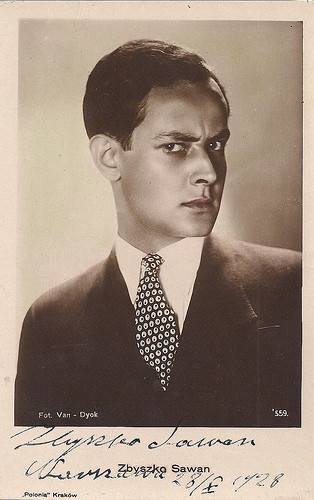
Polish postcard by Polonia, Krakow, no. 559. Photo: Van Dyck. Signature from 1928. Collection: Joanne.
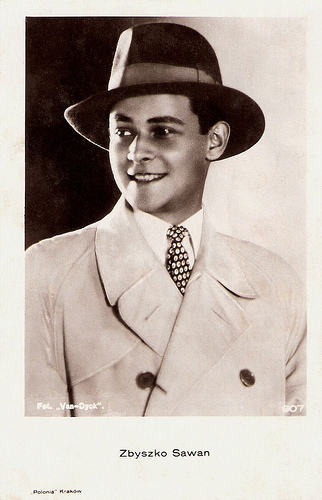
Polish postcard by Polonia, Krakow, no. 907. Photo: Van Dyck.
Polish actor Zbigniew (or Zbyszko) Sawan (1904–1984) starred both in silent and sound films, and was also a respected stage actor in his country. He also worked as a theatre director and manager.

Italian postcard by G.B. Falci, Milano. Distr. S.A.G. Leoni, No. 133. Diana Karenne as Maria, Duchess de Lardi in French-German coproduction Casanova (Alexander Volkoff, 1927), partly shot on location in Venice.
Polish-born actress Diana Karenne (1888-1940) was one of the divas of Italian silent cinema.

Austrian postcard by Iris Verlag, no. 625. Photo: Sascha.
Handsome and athletic Austrian-Polish actor Igo Sym (1896-1941) played classy gentlemen, aristocrats and army officers in Polish, Austrian and German films of the 1920s. After the German Invasion of Poland he decided to co-operate with the Nazis and in 1941 he was killed by members of the Polish resistance movement.

Polish postcard by Edition Victoria. Photo: Lux. Publicity still for Dzikuska/Savage (Henryk Szaro, 1928) with Marja Malicka and Zbyszko Sawan . Collection: Joanna.
Polish actress Maria or Marja Malicka (1900-1992) appeared both in silent and sound films. She was married to Zbigniew Sawan.
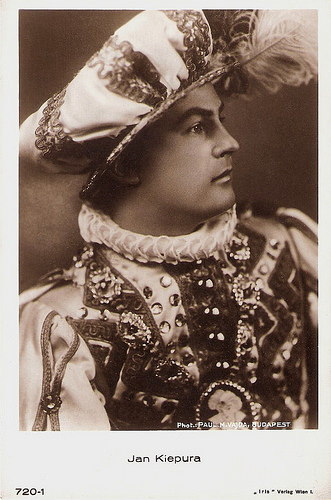
Austrian postcard by Iris-Verlag, Wien, no. 720-1. Photo: Paul M. Vajda, Budapest.
Polish actor and singer Jan Kiepura (1902-1966) was one of the grand tenors of the 20th century and with his handsome smile he also became a popular film star. He made his film debut in the silent Polish film O czym sie nie mysli (Edward Puchalski, 1926). Solo and together with Marta Eggerth he starred in many popular film operettas of the 1930s.
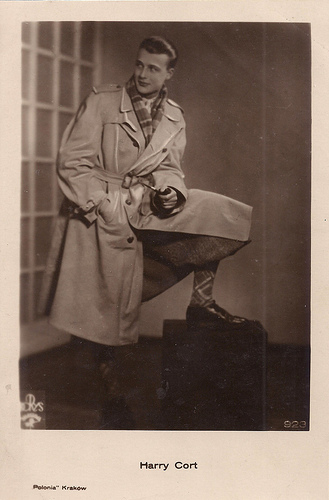
Polish postcard by Polonia, Krakow, no. 923. Collection: Joanna.
Polish actor Harry Cort (1905-?) came from a royal dynasty and had a short film career with starring roles in three silent films, 9:25. Przygoda jednej nocy (1929), Halka (1930) and Karuzela zycia (1930).
Source: Le Giornate del Cinema Muto.

Polish postcard. Photo: publicity still for the play Sumurun. Collection: Marlene Pilaete.
Polish film actress Pola Negri (1894-1987) achieved notoriety as a femme fatale in silent films between 1910s and 1930s.

Italian postcard by Ed. A. Traldi, Milano, no. 328. Photo: Fontana.
Polish actress Soava Gallone (1880-1957) was one of the divas of the Italian silent cinema.

Polish postcard, no. 83. Photo: publicity still for Huragan/Hurricane (Joseph Lejtes, 1928) with Zbyszko Sawan and Aleksander Zelwerowicz. Collection: Joanna.
Aleksander Zelwerowicz (1877-1955) was a Polish actor, director, theatre president and a teacher. He received the Order of Polonia Restituta, one of Poland's highest Orders. He is also one of the Polish Righteous among the Nations, recognised by Yad Vashem as non-Jews who saved Jews from extermination during the Holocaust.

Italian postcard, no. 30. Collection: Didier Hanson.
Polish singer and actress Helena Makowska (1893-1964) was a beautiful diva of the Italian silent cinema in the 1910s. During the 1920s she moved to Berlin and also became a star of the German cinema.

Polish postcard by BHK, no. 7. Photo: Sfinks. Publicity still for Tredowata/The Leper (Boleslaw Mierzejewski, Edward Puchalski, 1927). Collection: Didier Hanson.
Jadwiga Smosarska (1898-1971) was the biggest star of the Polish cinema of the pre-WW II era. From 1919 on, the Polish actress made more than 25 silent and sound films. She also was very successful on stage. When the Nazis invaded Poland in 1939, she fled to the US. In 1970, she returned to Poland.

Polish postcard by Polonia, Krakow, no. 559. Photo: Van Dyck. Signature from 1928. Collection: Joanne.

Polish postcard by Polonia, Krakow, no. 907. Photo: Van Dyck.
Polish actor Zbigniew (or Zbyszko) Sawan (1904–1984) starred both in silent and sound films, and was also a respected stage actor in his country. He also worked as a theatre director and manager.

Italian postcard by G.B. Falci, Milano. Distr. S.A.G. Leoni, No. 133. Diana Karenne as Maria, Duchess de Lardi in French-German coproduction Casanova (Alexander Volkoff, 1927), partly shot on location in Venice.
Polish-born actress Diana Karenne (1888-1940) was one of the divas of Italian silent cinema.

Austrian postcard by Iris Verlag, no. 625. Photo: Sascha.
Handsome and athletic Austrian-Polish actor Igo Sym (1896-1941) played classy gentlemen, aristocrats and army officers in Polish, Austrian and German films of the 1920s. After the German Invasion of Poland he decided to co-operate with the Nazis and in 1941 he was killed by members of the Polish resistance movement.

Polish postcard by Edition Victoria. Photo: Lux. Publicity still for Dzikuska/Savage (Henryk Szaro, 1928) with Marja Malicka and Zbyszko Sawan . Collection: Joanna.
Polish actress Maria or Marja Malicka (1900-1992) appeared both in silent and sound films. She was married to Zbigniew Sawan.

Austrian postcard by Iris-Verlag, Wien, no. 720-1. Photo: Paul M. Vajda, Budapest.
Polish actor and singer Jan Kiepura (1902-1966) was one of the grand tenors of the 20th century and with his handsome smile he also became a popular film star. He made his film debut in the silent Polish film O czym sie nie mysli (Edward Puchalski, 1926). Solo and together with Marta Eggerth he starred in many popular film operettas of the 1930s.

Polish postcard by Polonia, Krakow, no. 923. Collection: Joanna.
Polish actor Harry Cort (1905-?) came from a royal dynasty and had a short film career with starring roles in three silent films, 9:25. Przygoda jednej nocy (1929), Halka (1930) and Karuzela zycia (1930).
Source: Le Giornate del Cinema Muto.
Published on October 01, 2016 22:00
September 30, 2016
EFSP's Dazzling Dozen: At Home in Antiquity
Today is the opening of the exhibition Alma-Tadema, At Home in Antiquity at the Fries Museum in Leeuwarden, The Netherlands. The Dutch-born painter Sir Lawrence Alma-Tadema (1836-1912) was the most successful and seductive storyteller of his day. He accomplished this by an innovative use of space in his work. Through his great knowledge of archaeology and classical antiquity he managed to bring the days of ancient Rome to life in paintings. His scenes were received so enthusiastically all over the world that our present image of classical antiquity was influenced by them. In the European cinema and in Hollywood too, Alma-Tadema’s interpretation caught on and became the basis for seminal films about this era, from the Italian epics of the 1910s to Ridley Scott's Gladiator (2000).Today 12 postcards about films, inspired by the work of this remarkable artist, who probably had been a filmmaker had he lived later.
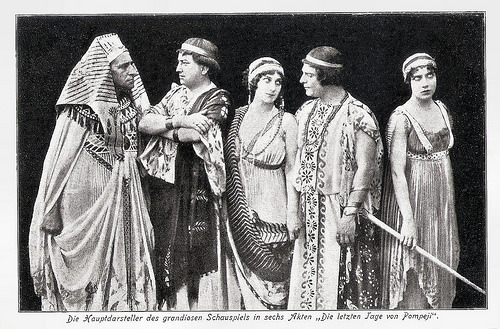
German postcard by Rodera-Lichtspiele, Dresden, 1913. Publicity still for the Italian silent epic Gli ultimi giorni di Pompei/The Last Days of Pompeii (Eleuterio Rodolfi, 1913). From left to right: Antonio Grisanti as Arbaces, the Egyptian High Priest of Isis; Cesare Gani Carini as Apecides, a disciple of Arbaces and the brother of Jone; Eugenia Tettoni Fior as Jone; Ubaldo Stefani as Glaucus, Jone's lover; and Fernanda Negri Pouget as the blind slave Nidia. The film was produced by Società Anonima Ambrosio.
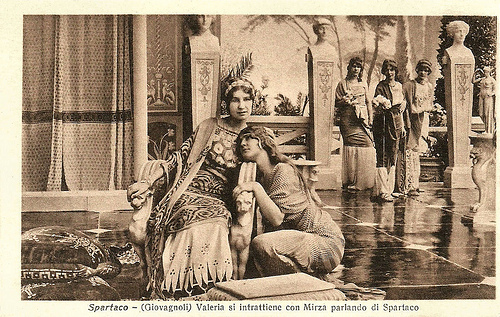
Italian postcard. Photo: publicity still for Spartaco (Enrico Vidali, 1913). Caption: Valeria si intrattiene con Mirza parlando di Spartaco (Valeria sits with Mirza, talking about Spartacus). Spartaco's sister Mirza (Cristina Ruspoli) has become the slave of Crassus' daughter Valeria (Maria Gandini). Valeria becomes interested in Spartacus because of what Mirza tells about him. In other versions Mirza is called Idamis, and Valeria Elena.
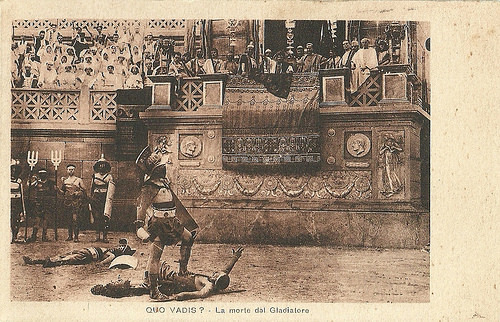
Italian postcard Photo: Cines. Publicity still for the early epic Quo vadis? (Enrico Guazzoni, 1913), adapted from Henryk Sienkiewicz's classic novel and the biggest film hit of 1913 worldwide. Caption: The death of the gladiator. This image cites Jean-Léon Gérôme's famous painting Pollice verso (Thumbs down, 1872) and was often used in the publicity for the film. In the back the emperor Nero (Carlo Cattaneo) makes the sign of thumbs down, sign for the conqueror to kill his adversary. Flanking Nero are left Tigellinus (Cesare Moltini) and right Petronius ( Gustavo Serena ). Left of the imperial box the Vestal Virgins are seated.
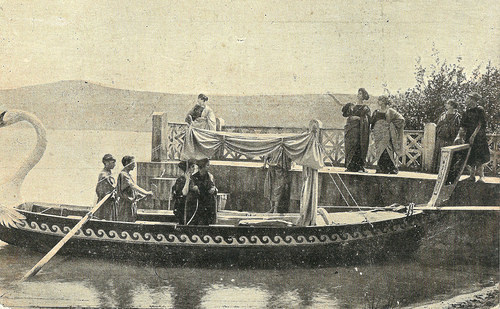
Spanish postcard for Amatller Marca Luna Chocolate, Series 8. Photo: Palatino Film. Elena Sangro as Fabiola and signora Poletti as her niece Agnese in Enrico Guazzoni's Fabiola (1918). When the persecutions of the Christians in Rome become too rough, Fabiola takes her niece Agnese to her villa in the countryside.
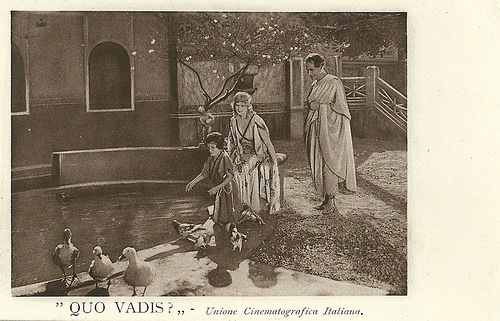
Italian postcard by Edizione L'Argentografica, Torino. Publicity still for the Italo-German epic Quo Vadis? (Gabriellino D'Annunzio, Georg Jacoby, 1924), one of the many adaptations of the classic novel by Henryk Sienkiewicz, with Lilian Hall-Davis as Licia.
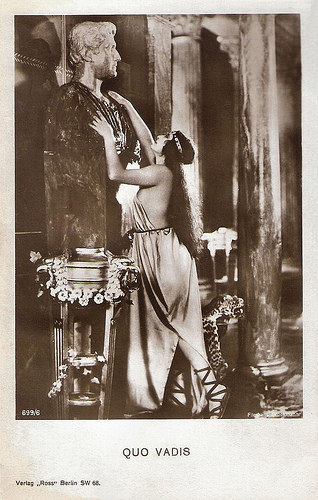
German postcard by Ross-Verlag, Berlin, no. 699/6, 1919-1924. Photo: Filmhaus Brückmann. Publicity still for Quo Vadis? (Gabriellino D'Annunzio, Georg Jacoby, 1924) with Rina De Liguoro .
Alma-Tadema defined our picture of Roman antiquity
Sir Lawrence Alma-Tadema's painted scenes appeal to the imagination and are totally convincing. Even though we may not be aware of it, our picture of Roman antiquity has been largely defined by Alma-Tadema.
The exhibition explores how this came to be by very closely following Alma-Tadema’s personal life and artistic career.
No one could paint as convincingly as Alma-Tadema, so it is hardly surprising that Cinecittá and Hollywood were only too eager to convert his paintings into moving images for their Roman spectacles.
From the silent era on, film directors were after all looking for a visual language for the new mass medium of film and Alma-Tadema provided them with the blueprint for it. And this continues on to this day.
Director Ridley Scott studied Alma-Tadema when making his successful films Gladiator (2000) and Exodus (2014). Scott’s production designer, Arthur Max, sees Alma-Tadema as someone who shows us Rome as we want it to look like, not necessarily as it really was.
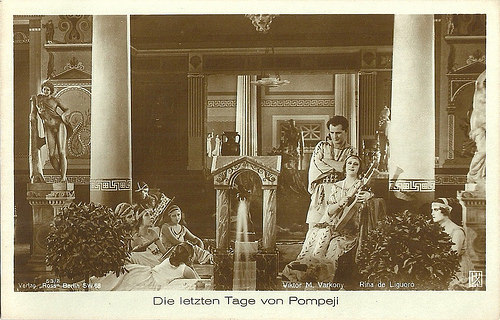
German postcard by Ross Verlag, no. 53/2. Photo: Hisa. Publicity still for the Italian silent epic Gli ultimi giorni di Pompei/The Last Days of Pompeii (Carmine Gallone, Amleto Palermi, 1926). The film was based on the 1834 novel The Last Days of Pompeii by Edward Bulwer-Lytton. On the photo, Glaucus ( Victor Varconi ) listens to beautiful and rich Greek Ione ( Rina De Liguoro ) playing the harp. The statue left was copied from an original Roman one.
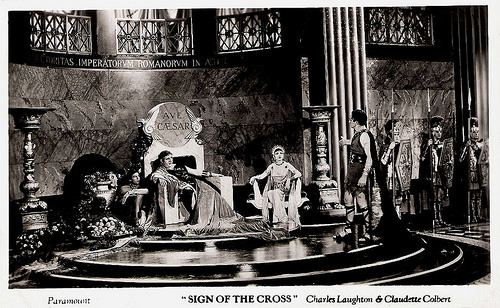
British postcard in the series Film Shots by Film Weekly. Photo: Paramount. Publicity still of The Sign of the Cross (Cecil B. De Mille, 1932) with Claudette Colbert and Charles Laughton .

British postcard in the series Film Shots by Film Weekly. Photo: Paramount. Publicity still for The Sign of the Cross (Cecil B. De Mille, 1932) with Fredric March.
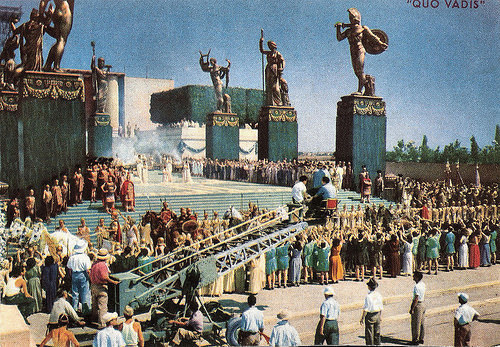
Italian postcard by A. Mondadori, Verona. Publicity still for Quo Vadis (Mervyn LeRoy, Anthony Mann, 1951). Caption: In Rome, Italy, Technicolor cameras film a scene for M.G.M.'s Quo Vadis. Roman soldiers parade before Nero's palace here.

French postcard by Editions P.I., Paris, no. 831, 1956. Photo: Paramount Pictures Inc. Yul Brynner as Ramses in The Ten Commandments (Cecil B. DeMille, 1956).
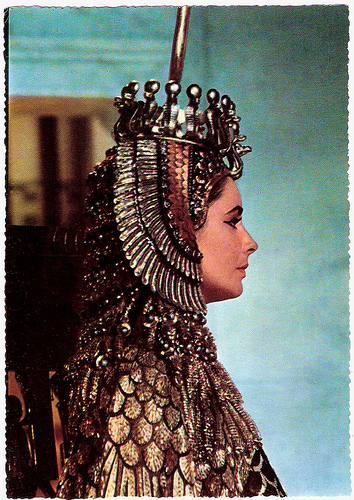
Belgian postcard by SB (Uitgeverij Best), Antwerpen (Antwerp). Photo: still for Cleopatra (Joseph L. Mankiewicz, 1963) with Elizabeth Taylor .
Alma-Tadema in film. Source: Fries Museum (YouTube).
Sources: Fries Museum and Eye.

German postcard by Rodera-Lichtspiele, Dresden, 1913. Publicity still for the Italian silent epic Gli ultimi giorni di Pompei/The Last Days of Pompeii (Eleuterio Rodolfi, 1913). From left to right: Antonio Grisanti as Arbaces, the Egyptian High Priest of Isis; Cesare Gani Carini as Apecides, a disciple of Arbaces and the brother of Jone; Eugenia Tettoni Fior as Jone; Ubaldo Stefani as Glaucus, Jone's lover; and Fernanda Negri Pouget as the blind slave Nidia. The film was produced by Società Anonima Ambrosio.

Italian postcard. Photo: publicity still for Spartaco (Enrico Vidali, 1913). Caption: Valeria si intrattiene con Mirza parlando di Spartaco (Valeria sits with Mirza, talking about Spartacus). Spartaco's sister Mirza (Cristina Ruspoli) has become the slave of Crassus' daughter Valeria (Maria Gandini). Valeria becomes interested in Spartacus because of what Mirza tells about him. In other versions Mirza is called Idamis, and Valeria Elena.

Italian postcard Photo: Cines. Publicity still for the early epic Quo vadis? (Enrico Guazzoni, 1913), adapted from Henryk Sienkiewicz's classic novel and the biggest film hit of 1913 worldwide. Caption: The death of the gladiator. This image cites Jean-Léon Gérôme's famous painting Pollice verso (Thumbs down, 1872) and was often used in the publicity for the film. In the back the emperor Nero (Carlo Cattaneo) makes the sign of thumbs down, sign for the conqueror to kill his adversary. Flanking Nero are left Tigellinus (Cesare Moltini) and right Petronius ( Gustavo Serena ). Left of the imperial box the Vestal Virgins are seated.

Spanish postcard for Amatller Marca Luna Chocolate, Series 8. Photo: Palatino Film. Elena Sangro as Fabiola and signora Poletti as her niece Agnese in Enrico Guazzoni's Fabiola (1918). When the persecutions of the Christians in Rome become too rough, Fabiola takes her niece Agnese to her villa in the countryside.

Italian postcard by Edizione L'Argentografica, Torino. Publicity still for the Italo-German epic Quo Vadis? (Gabriellino D'Annunzio, Georg Jacoby, 1924), one of the many adaptations of the classic novel by Henryk Sienkiewicz, with Lilian Hall-Davis as Licia.

German postcard by Ross-Verlag, Berlin, no. 699/6, 1919-1924. Photo: Filmhaus Brückmann. Publicity still for Quo Vadis? (Gabriellino D'Annunzio, Georg Jacoby, 1924) with Rina De Liguoro .
Alma-Tadema defined our picture of Roman antiquity
Sir Lawrence Alma-Tadema's painted scenes appeal to the imagination and are totally convincing. Even though we may not be aware of it, our picture of Roman antiquity has been largely defined by Alma-Tadema.
The exhibition explores how this came to be by very closely following Alma-Tadema’s personal life and artistic career.
No one could paint as convincingly as Alma-Tadema, so it is hardly surprising that Cinecittá and Hollywood were only too eager to convert his paintings into moving images for their Roman spectacles.
From the silent era on, film directors were after all looking for a visual language for the new mass medium of film and Alma-Tadema provided them with the blueprint for it. And this continues on to this day.
Director Ridley Scott studied Alma-Tadema when making his successful films Gladiator (2000) and Exodus (2014). Scott’s production designer, Arthur Max, sees Alma-Tadema as someone who shows us Rome as we want it to look like, not necessarily as it really was.

German postcard by Ross Verlag, no. 53/2. Photo: Hisa. Publicity still for the Italian silent epic Gli ultimi giorni di Pompei/The Last Days of Pompeii (Carmine Gallone, Amleto Palermi, 1926). The film was based on the 1834 novel The Last Days of Pompeii by Edward Bulwer-Lytton. On the photo, Glaucus ( Victor Varconi ) listens to beautiful and rich Greek Ione ( Rina De Liguoro ) playing the harp. The statue left was copied from an original Roman one.

British postcard in the series Film Shots by Film Weekly. Photo: Paramount. Publicity still of The Sign of the Cross (Cecil B. De Mille, 1932) with Claudette Colbert and Charles Laughton .

British postcard in the series Film Shots by Film Weekly. Photo: Paramount. Publicity still for The Sign of the Cross (Cecil B. De Mille, 1932) with Fredric March.

Italian postcard by A. Mondadori, Verona. Publicity still for Quo Vadis (Mervyn LeRoy, Anthony Mann, 1951). Caption: In Rome, Italy, Technicolor cameras film a scene for M.G.M.'s Quo Vadis. Roman soldiers parade before Nero's palace here.

French postcard by Editions P.I., Paris, no. 831, 1956. Photo: Paramount Pictures Inc. Yul Brynner as Ramses in The Ten Commandments (Cecil B. DeMille, 1956).

Belgian postcard by SB (Uitgeverij Best), Antwerpen (Antwerp). Photo: still for Cleopatra (Joseph L. Mankiewicz, 1963) with Elizabeth Taylor .
Alma-Tadema in film. Source: Fries Museum (YouTube).
Sources: Fries Museum and Eye.
Published on September 30, 2016 22:00
Paul van Yperen's Blog
- Paul van Yperen's profile
- 13 followers
Paul van Yperen isn't a Goodreads Author
(yet),
but they
do have a blog,
so here are some recent posts imported from
their feed.



